The Student Newspaper of The Nueva School San Mateo, California



Privilege, or a lack of it, is not always visible. Yet, it can be keenly felt in social interactions. How do Nueva students approach socioeconomic differences they encounter amongst peers?
Part I: Traversing wealth in and out of the classroom
The annual Book Fair was in full swing, and Brenna A. M.’25 was excited. She rushed to a friend and told her about the $30 they each had in their Nueva accounts for purchasing books—a benefit for students who receive financial assistance. Her friend was resistant.
“I told [my friend] we should go over and use the money and she said no, because it was too embarrassing for her,” Brenna said. “She said, ‘I don’t want to tell them I have the money because I’m on financial aid.’”
While students do not need to actually

reveal their financial assistance status to use the money during the Book Fair, the real discomfort with using those funds still remains, a pervasive feeling that goes beyond this one experience.
Nueva’s financial assistance program goes beyond tuition; the school covers the cost of additional programs and services, generally at the same percentage of the financial assistance families receive. This can range from transportation, athletics gear, opt-in electives and activities, senior prom and senior yearbook pages—to spending money for overnight trips, college application fees, and standardized tests taken at Nueva. The goal is that “every Nueva student can take part in the full Nueva experience.”

Yet, students who are entitled to these benefits can experience discomfort around using them. Students appreciate that they’re available, but may also feel sensitivity, shame, or embarrassment.
These moments are shaped by class consciousness, the self-understanding and various beliefs around personal socioeconomic status—on its own and in regards to others. It can materialize as embarrassment around receiving financial assistance, or, conversely, self-consciousness around having privilege. It is shaped by how wealth is generally discussed—or not discussed—as well as the overall distribution of wealth and privilege present.
Nueva is located in the Bay Area, one of the most expensive areas to live in the


country, where the gap between affluence and economic vulnerability is wide. The student experience at Nueva includes two beautiful campuses and facilities, state-ofthe-art labs and maker spaces, yearly trips, and modern technology and software; these benefits are reflected by both a significant tuition ($59,720 for the Upper School in 2024–25) and a generous community that supports the school through annual fund giving.
In the Upper School, students come from a range of socioeconomic backgrounds, zip codes, and middle schools.
Continued on Page 10

By Anwen C. Staff Writer
Nueva tuition set to increase by 4.75% in the 2025-2026 school year.
In the coming 2025–2026 school year, Nueva’s yearly tuition will see a 4.75% increase, as well as an added $400 in trip costs for the Upper School. That might not seem like much at first glance, but for families already budgeting for private school costs, the difference adds up.
For the current 2024–2025 school year, Upper School tuition, which includes the cost of trips, totals $63,720. Going into 2026, that number will rise to $66,960—an increase of $3,240.
“The primary factors [driving tuition] are the increase in CPI (consumer price index) and other market forces, especially in the Bay Area,” said Brett Dyer, Nueva’s Director of Finance and Administration. While the Bay Area’s average inflation rate as of February 2025 remains on par with the national average of 2.8%, the cost of living has risen dramatically. This has become a major issue for Nueva’s personnel and staff, who account for nearly 64% of school spending across both campuses.
“The school is looking to make sure that it is appropriately compensating its faculty and staff,” Dyer explained. “Because we don't receive any funds from anywhere else—like any government agencies or grants—the source of our funds is the parent community, mostly through tuition.”
Nueva prides itself on its low teacherto-student ratio of 6:1, ensuring that every student gets the support they need to thrive both academically and socially. In order to retain these teachers, it’s crucial that they are compensated fairly and competitively.
But beyond maintaining strong staff salaries, there are other financial needs at play: operational costs, technology investments, and maintaining campus facilities. Additionally, Nueva’s financial assistance program has seen significant
By Emily F. Staff Writer
For one week in March, the first floor fireplace and hallway was transformed into a bookstore as Nueva parent volunteers hosted the annual Book Fair in collaboration with Books Inc.
“My happiest moments over the years have come from seeing how much joy it brings teachers and staff, as they stop in throughout the week to excitedly pick through the selection, and share recommendations with fellow teachers and students,” said Sári Ordódy, a volunteer for the book fair.
This annual spring event creates a place for students and staff to find new books to read, with many titles in the selection. “It's wonderful that we get the chance to see so many new and interesting books, especially because as high schoolers, we generally have less time to read for leisure compared to middle or elementary school,” Alicia C. ’26 said.
increases over the past few years: 7.2 million dollars in financial assistance were awarded schoolwide during the 2023–2024 school year, up from the 5 million distributed during the 2019–2020 season.
Nueva has had a history of increasing tuition to meet the school’s needs and developments. In the pre-pandemic 2018–2019 year, tuition (excluding trips) rose by 6.6%, followed by annual increases ranging between 3–4.5% over the next six years. So while the upcoming 4.75% hike isn’t the steepest in the school’s history, it marks a gradual return to higher rates of increase. The additional $400 for trip costs also signals a break from the past seven years, during which trip costs remained the same.
Juggling these tuition increases with financial sustainability and socioeconomic diversity has been a tricky balancing act, however.
“The school strives to make sure that we raise tuition enough for this year, as well as being sustainable in the future,” Dyer explains.
In recent years, the school has worked to strengthen its endowment, providing more long-term financial stability. Fundraising and donations also help lighten the load, but tuition remains the school’s financial backbone. To keep things running smoothly, new budgeting strategies—like stricter expense approvals—have been put in place to ensure every dollar is well spent.
As the cost of living continues to rise in the Bay Area, more tuition increases are in the books. Just how steep they’ll be, though, will depend on the economic landscape. In the meantime, families can expect ongoing discussions about financial planning, tuition trends, and how to keep the school accessible.
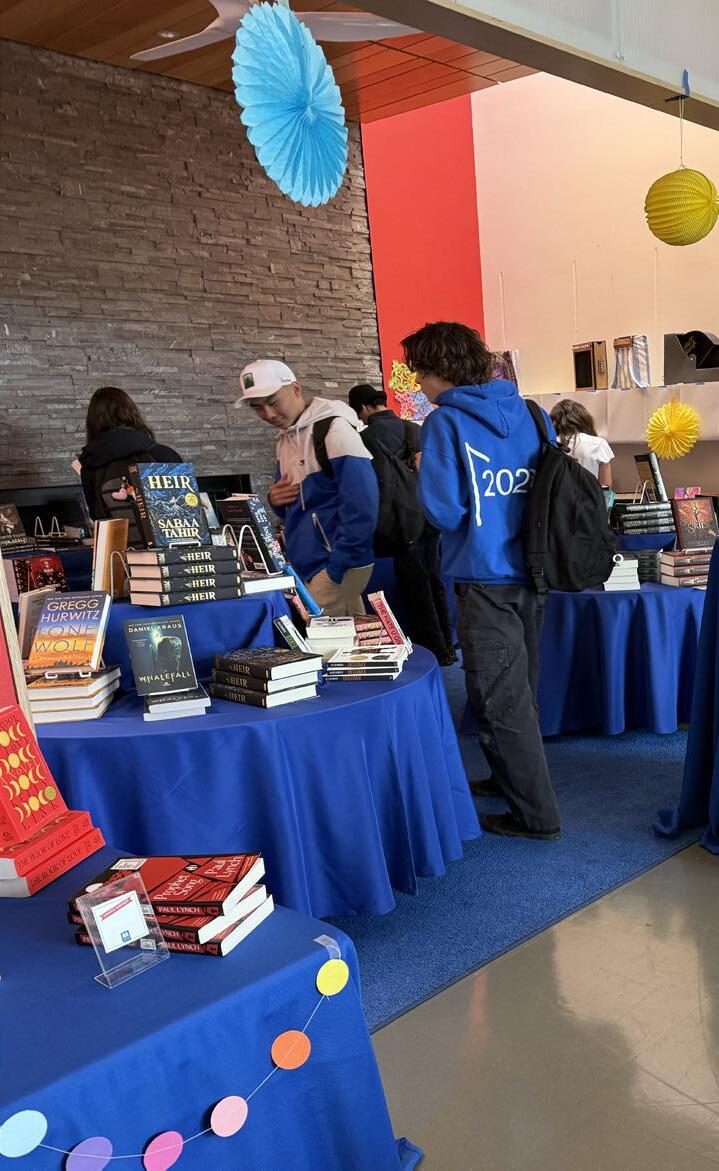
The fantasy novel The House in the
is one such book, particularly loved by Lee Holtzman and Max K. ’26.
The curated selection and warm atmosphere contributed to an increase in sales compared to last year.
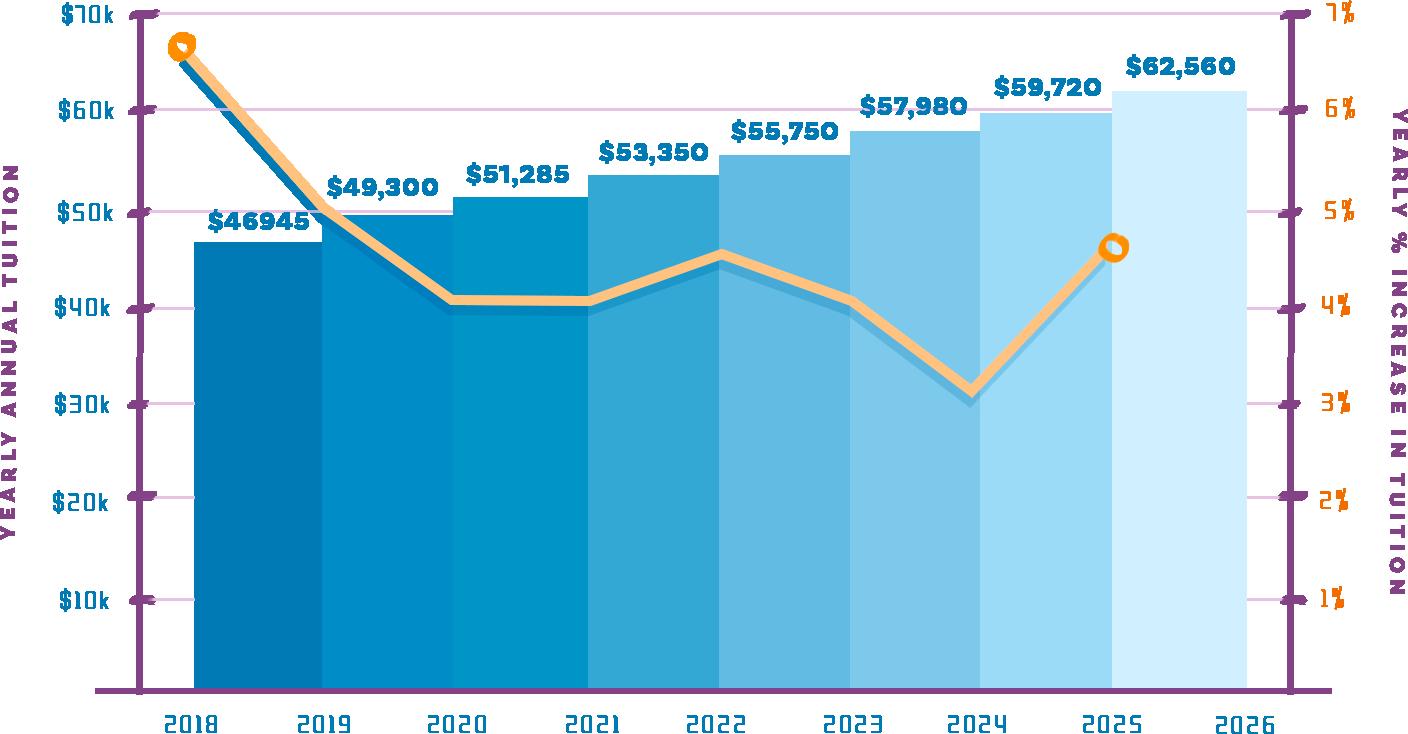

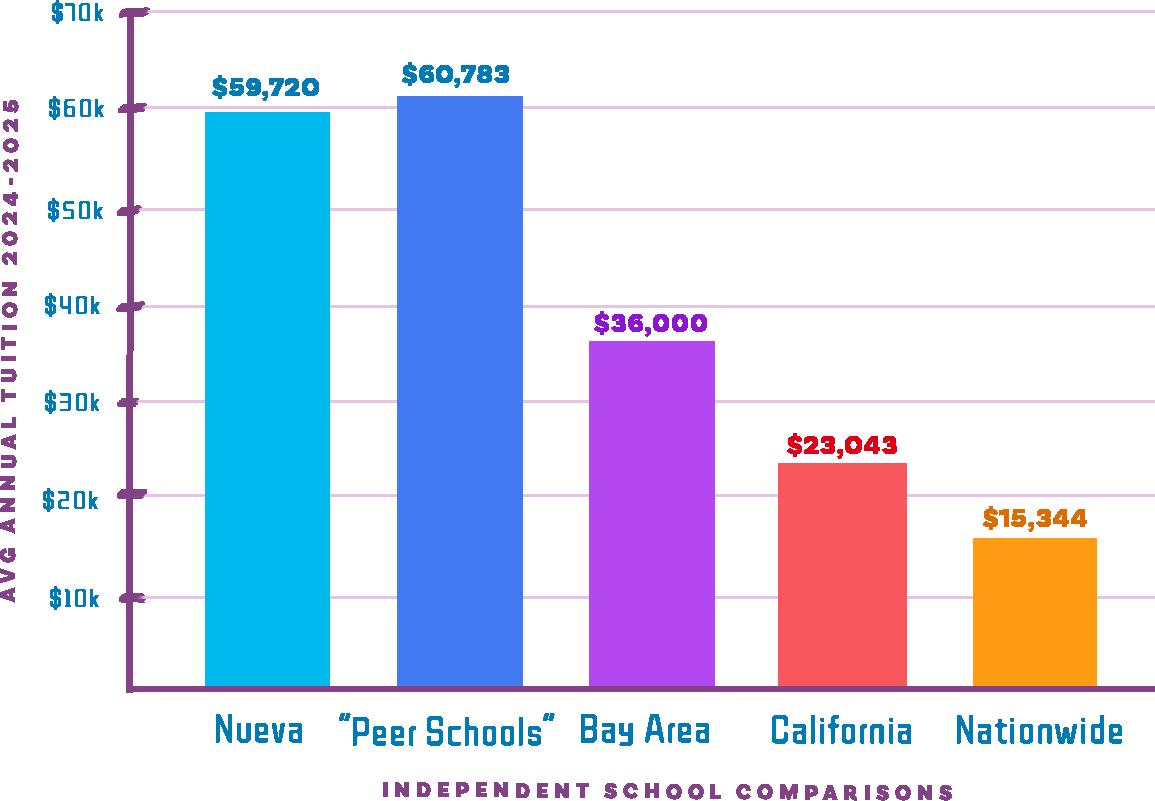
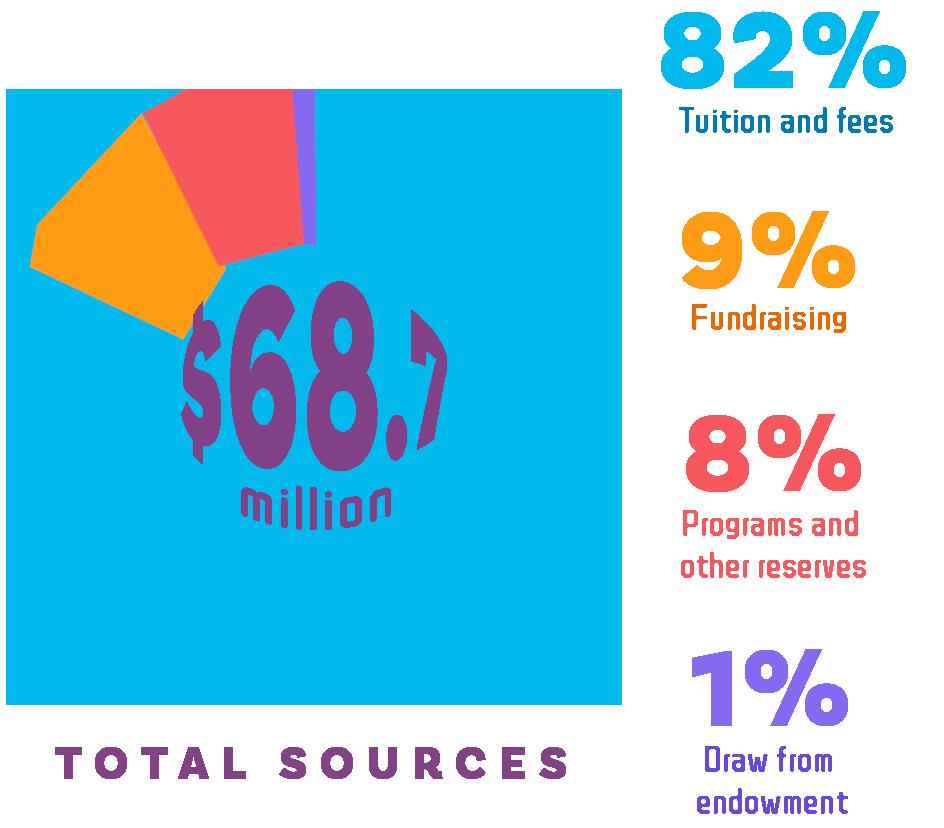

By Ellie L. Culture Editor







By Alvin Y. News Editor
Military Plans Leaked After Mistake
On March 24, The Atlantic posted leaked excerpts from a high-profile group chat on Signal—a non-secure commercial app—after National Security Advisor Michael Waltz allegedly added the newspaper’s Editor in-Chief Jeffery Goldberg to the chat. The group chat was filled with Cabinet officials including Vice President JD Vance, Defense Secretary Pete Hegseth, and C.I.A Director John Ratcliffe. Following the data leak, US President Donald Trump has called the Atlantic’s article a “witch hunt,” while also personally attacking Goldberg. He then blamed former President Joe Biden for not carrying out the airstrike during his administration.
President Trump said none of the data shared was confidential and it isn’t uncommon for government officials to use Signal for communication.

Dangerous Storms in the Southeast
On March 15, a massive storm caused multiple tornadoes that devastated parts of the Midwestern region and is currently moving toward the Southeast region. In total, the storm has created more than 90 separate tornadoes in 13 states, started over 130 wildfires in Oklahoma and spread smoke around the area; caused multiple deadly multi-car crashes that took eight lives; and brought extreme weather with hail, winds reaching over 200 miles per hour, and flash flood warnings. Across Missouri, Arkansas, Illinois, and Mississippi, there have been at least 39 fatalities, injuries, and widespread destruction of property.
At least 36 million people are in the predicted storm zone in Alabama, more of Mississippi, Georgia, and Tennessee, all of whom have been warned by the state government to evacuate from their homes.

Trump v. Columbia University
In a letter sent to Columbia University on March 14, the government threatened to permanently end the Ivy League’s federal funding. Already withholding $400 million from the university, the letter demanded that the university put its South Asian, Middle Eastern, and African studies departments under “academic receivership,” essentially placing the studies under an external head. Additionally, the letter called for admission system reform, the banning of masks to prevent identity protection, and the disciplinary process to hold student groups accountable. The school has proposed a deal to President Donald Trump where Columbia would receive its $400 million in return for "[engaging] in constructive dialogue with our federal regulators." The government has also arrested Columbia University alumni Mahmoud Khalil for his accused role in organizing protests, where participants distributed proHamas fliers. It is unclear if Khalil knew about these fliers.

San Mateo voters approved Christina Corpus’s
removal after an investigation revealed her alleged abuse of power and romantic relationship with the assistant sheriff
By Josie B. Editor in-Chief
After six years of Carlos Bolanos’s steady hold on the sheriff’s office, he had finally found a worthy challenger—his own protégé. For years, Bolanos had supported and encouraged Christina Corpus in her rise through the San Mateo police department to become captain of its Millbrae office.
After six years of Carlos Bolanos’s steady hold on the sheriff’s office, he had finally found a worthy challenger—his own protégé. For years, Bolanos had supported and encouraged Christina Corpus in her rise through the San Mateo police department to become captain of its Millbrae office.
When reelection came in 2021, a year after the George Floyd Protests, many voters were looking for change. Corpus, young, fresh, qualified, entered the sheriff’s race as the face of progress.
Not only would she be the first woman and Latina elected to office, but she also promised to establish community-based policing, support immigrants, and set up clinician-led responses to mental health crises. She campaigned as a sheriff who would listen to her community.
On Jan. 8, 2023, the 26th sheriff in San Mateo County’s 167-year history was sworn in.
“It’s a new day,” Corpus said in her

inaugural ceremony. “We are going to be involved. We are going to be out in the community that we serve.”
Just over two years later, however, that community would overwhelmingly turn their backs on Corpus. On March 4, voters approved Measure A, granting the Board of Supervisors the authority to remove her from office. The measure passed with almost 85% of the vote.
The sheriff’s fall from grace began in July 2024 when a surge in complaints from police staff led the Board of Supervisors to hire retired Judge LaDoris Cordell to lead an investigation into her conduct.
After three months of speculation and accusations, the report delivered a blistering 400-page indictment of the sheriff.
Many allegations revolved around Corpus’s decision to hire real estate
agent Victor Aenelle, her secret romantic partner, as the “Sheriff’s Executive Director of Administration” without a public job opening or accepting other applicants. Not only did Aenelle have no experience to justify his role, but he also allegedly abused his position, falsely claiming the title of chief of staff and wearing a gold badge.
Corpus and her lover proceeded to “intimidate and retaliate against employees who spoke up against their illegal conduct,” according to the report.
Despite the vote, Corpus is adamant that she will not be resigning. She has filed a $10 million lawsuit against the county, alleging discrimination.
The Board of Supervisors will now move forward with the steps detailed in Measure A, which involve a board vote and a public hearing.

San Francisco Supervisor’s push for a permanent road closure to create public space has led to some local residents calling for his removal from office
By Natalie L. Managing Editor
After the permanent closure of a two-mile strip of the Upper Great Highway, a four-lane divided road running alongside Ocean Beach, the politician who pushed for the decision now risks losing his position.
San Francisco Board of Supervisor Joel Engardio sponsored Prop K, which was approved in November that closed the Upper Great Highway to vehicles to create a public open recreation space. While 55% of San Francisco voters supported the bill, 64% of the 34,000 registered voters in District Four—encompassing the Great Highway and much of the neighboring Sunset District— voted against it.
The road was first fully closed in 2020 by former Mayor London Breed during the shelter-in-place order to offer citizens additional open recreational space. Later, the closure was adjusted to only restrict cars on weekends.
Over the years, it’s become a popular spot for residents to exercise, bike, and stroll. Numerous free events have also been hosted in the space, such as a trick-or-treat event,
The Great Hauntway, that has taken place over the past four years.
Some residents view this as an invaluable pedestrian area. Rachelle, a homeowner in the Outer Sunset District since 2021 and parent to an infant, walks on the Great Highway “almost every day.”
“Having a young family in the neighborhood, I am very excited about having more park space—it’s a place for families to teach our kids how to ride a bike,” Rachelle said. “It fosters a sense of community that I didn’t feel like we had before.”
Still, opposition against Prop K among some Sunset District residents led to an effort to remove Engardio from office. Launched on Feb. 1, the campaign has until May 22 to collect signatures from one-fifth, or 9,911, of District Four’s registered voters. If Engardio is recalled, San Francisco Mayor Daniel Lurie would appoint a successor to complete his term, which runs until January 2027.
At the kickoff event held at the United Irish Cultural Center—an event venue located at the intersection of Wawona and 45th Avenue, just a five-minute walk from the Great Highway—organizers distributed pamphlets
and black-and-yellow “Recall Engardio” posters.
Some residents have since displayed these posters in their street-facing windows, citing commute times and new commercial development as primary concerns.
The official Recall Engardio website defines their reasons for the recall effort: “Instead of representing the majority of District 4, Joel has focused on catering to a small group while ignoring the voices of the people who elected him. He’s pushed divisive policies like permanently closing the Great Highway—without meaningful community input—creating traffic chaos and increasing stress for families and commuters.”
Others, like Rachelle, hang a “Stand with Joel” poster in their windows in support of Engardio.
“[Traffic times] don’t concern me; we have dozens of streets that go to the exact same places,” she said. “I understand that some people may disagree with his policies but I don’t think that’s a reason to recall him. It’s an expensive distraction from things that improve our neighborhood.”
As Sunset District residents remain divided, the coming months will determine if the recall gains momentum or if Engardio can advance his agenda.
Community members came together last month as part of Nueva’s semiannual Coffeehouse event
By Kayla L. Opinion Editor
Eleanor A. ’25 was nervous while waiting in the wings, as she prepared for a performance unlike any other in the lineup of 20 Coffeehouse performers that night. She took a deep breath, closed her eyes, and debuted “Morag Duncan” for the crowd—on the Great Highland bagpipe.
The audience gave Eleanor the first standing ovation of the night.
“My friends were all really supportive. And that gave me [a] boost. Because, even if it goes terribly, most people have probably never seen bagpipes live,” Eleanor said.
“I think the general consensus is that the bagpipes were the best part,” said student council Arts Representative Chloe M. ’25.
Chloe was one of the lead organizers for Nueva’s semiannual, celebrated tradition of Coffeehouse. The event hosted singers, dancers, and poetry reciters to share their talents with an audience of students, faculty, and parents. Attendees and performers alike snuggled into the WRC, made cozy by green couches, hot chocolate, and fairy lights, on the first Friday night of March.
Math teacher Andrew Alexander sponsored the event and read aloud a poem, “The Cave of Making,” with an enchanting narration that stunned the audience. He has participated in Coffeehouse since first joining Nueva because of the unique environment that the event affords community members.
“What I see at Coffeehouse is all [of students’] talents and passion, but

without that added layer of stress and competitiveness. It's like [their] purest and best form,” he said.
Behind the scenes, the community-favorite event was supported by the student council Arts Cabinet, other student council members, and The Nueva Current staff. Assistant Director of Communications LiAnn Yim and Alexander supported the event as faculty advisors.
“It's kind of sweet to see [Coffeehouse] come to fruition. At the end of the day, I know I can't do it alone. So it's just nice to have everyone come together,” Chloe said.
On stage, students and teachers from various backgrounds converged to
By Lexie S. Staff Writer
contribute their artistic talents to the stage. Freshman bands played a soulful rendition of “Just the Two of Us” and “R U Mine?” an energetic rock song, while the Nueva Dance Team and Nueva Notes acapella group contributed energetic performances.
As a longstanding tradition, Coffeehouse will be back next fall, but many of the senior performers will not. Medina performed at her last Coffehouse alongside senior friends Brenna A. M. ’25 and Silvia G-P. ’25, and she said that will cherish the event’s showcase of “the wide variety of performers and talents that we have in our community.”
We've rounded up the best of culture to watch, listen, eat, and do right now.


Adolescence, a new drama miniseries streaming on Netflix, begins with the arrest of a young boy for the murder of his schoolmate. The show explores themes of youth violence and its underlying causes, as well as the impact of social media on young minds. The filmmaking is powerful: each scene was filmed in one long take, which director Philip Barantini uses to emphasize the intense emotions. The unique filming technique leaves you enveloped in each character’s headspace, and keeps you thinking about it for days after.
As springtime approaches, embrace the season by going to a picnic with your friends or family. In addition to the delicious foods, picnics are also an opportunity to do things you might not normally put aside time to do, like wildlife watching or nature journaling. Crissy Field is my top picnic recommendation. A peaceful park residing on the edge of Presidio, Crissy Field has it all, with access to the beach, a vibrant grassy area, a path next to Palace of Fine Arts, and a playground and a youth center.
New coffee shop offers a fresh take on classic coffees
By Anvi M. Staff Writer

Afull day of school after pulling an all nighter felt more grueling than the last minute Major Assignment grinds on the hori zon. Tired, I was looking for coffee shops nearby that had something intriguing to wake me up (the caffeine being a bonus), when Kaizen & Coffee showed up on Google Maps, only 0.3 miles away.
At only a seven minute walk from the Upper School, the coffeeshop is an accessible and easy way to get some much needed energy in the morning, or a snack after school. Though the store closes at 4 p.m., hustling for a Strawberry Matcha was imperative, since they run out of ingredients quickly in the afternoon.
Two drinks stood out to me–the Miso Caramel Latte and the Mission Mocha. The Miso Caramel was salty and slightly nutty, which unexpectedly paired well with the slightly bitter coffee. The Mission Mocha, however, had an especially unique combo: Kaizen & Coffee added Gochugaru pepper to the already rich drink. Though I was admittedly nervous to try it, the spice was just enough to leave an enjoyable burn in my mouth—and the taste of the dandelion chocolate and coffee still came through.
While the drinks were good, the price surprised me— the average price per drink was around $7.50, making it on the higher end, especially for high school students. The drinks were delicious, but I would consider this coffee shop more of a treat than an everyday coffee.
Regardless, Kaizen & Coffee has a relaxing environment for studying after school, despite its small space. When I visited after school, the line was short and the cafe was uncrowded, indie-pop music playing in the background. Once I managed to find a seat, I got out my computer and locked in on my homework, able to get a surprising amount of work done before they closed the shop up. Though it’s possible that the caffeine was getting to me a little, I found that Kaizen & Coffee offered a relaxing place for students to work and hang out after school, with unique drinks to accompany it.

I Said I Love You First is a pop album from newly engaged couple Selena Gomez and benny blanco. With 14 songs that range from upbeat to more woeful, the album explores the journey of their relationship. The production is innovative, starting off the album with a short clip of an emotional speech given by Gomez, recorded after concluding her time on Wizards of Waverly Place. This intimate introduction opens up the album to all of its themes of love and journeys. Gomez’s vocal expertise and blanco’s flowy production skills produces a multi-genre album that offers a variety of memorable tunes that will have you playing it on repeat.

Sunrise on the Reaping is the newest book to join the renowned Hunger Games franchise. A prequel set 24 years before the original trilogy, the book gives an earlier look into the Hunger Games saga and reveals insights that can be connected to the other books. The complex dystopian world portrayed in the book is so harrowing, yet that’s what makes it so intriguing—so much so that you won’t be able to put it down. As a new installment of one of the best series out there, it does not disappoint and is definitely worth being added to your reading list.

Drive to Survive season 7: the good, the bad, and the missing
By Ethan H. Sports Editor
S
ince 2018, viewership of Formula 1 races on ESPN has nearly doubled. F1 has been booming in the United States, and much of this can be attributed to Netflix’s Drive to Survive docuseries, which takes viewers behind the scenes of the sport’s major events.
Released on March 7, the seventh season covers the 2024 Formula 1 World Championship. This past year was one of the most exhilarating in racing history, brimming with high-octane content for Netflix to use. Charles Leclerc finally won his home race in Monaco after years of bad luck, VCARB shocked fans by dropping the beloved Daniel Ricciardo mid-season, and Max Verstappen continued his dominance, winning his fourth consecutive championship.
But the biggest motorsports headline of 2024 came before the season started when seven-time world champion Lewis Hamilton announced he would depart Mercedes after 12 years to join Ferrari in 2025. Netflix expertly and thoroughly depicted the frenzy that enveloped the Paddock, exploring every party that was affected.
On one end, they followed Carlos Sainz—who would be forced out of Ferrari because of Hamilton’s move. Drive to Survive included everything from his legendary start to the season, winning a race just two weeks after an emergency appendicitis surgery, to his lengthy process of signing a new contract for 2025. Viewers get a raw and emotional glimpse into Sainz’s interactions with his manager, as well as his reflections on changing teams.
On the other end, Netflix also covered Mercedes’ decision to promote George Russell to replace Hamilton as their lead driver in 2025. However, in this storyline, the producers selectively left out important details to create a dramatic storyline, falling into old habits that have been previously criticized. Their narrative suggests that he proved himself worthy after winning the Belgian Grand Prix, leaving out that his win was eventually revoked for not meeting car regulations.
This subtle narrative twisting is not limited to Russell and has been a common criticism of the show. For instance, after Lando Norris won his first race, Red Bull’s Max Verstappen was congratulatory and defended the former against reporters downplaying his achievement. However, Drive to Survive included post-race video clips from different grand prix to paint the reigning champion as grumpy and antagonistic after taking second.
Season seven does deserve praise for its creativity, though. For instance, in episode seven, “In the Heat of the Night,” five drivers were given cameras to record their weekends at the Singapore Grand Prix in vlog style, leading to a much more personal experience where viewers can sit in on flights together, dinners, and padel games. With the drivers behind the camera, they have the wheel for their videos, and more humor and personality shine through. At the end of the episode, each driver gave a diary-style reflection on their race, creating the atmosphere of a casual 1-on-1 interaction rather than a typical interview.
While Drive to Survive’s storytelling techniques can be criticized for selective focus and misrepresentation, it still captures the essence of Formula 1’s intense drama and fierce rivalries. Fans can endlessly nitpick at Netflix all they want, but ultimately, the season does an honest job of representing all 10 teams throughout the hectic year. Overall: a seven out of 10 for season number seven.
Lady Gaga's newest release is a reclamation of her new and old sound
By Senna H. Staff Writer
Picture this: It’s 2011. Prince William and Kate Middleston’s marriage is official. HBO’s Game of Thrones has seized pop culture. And Lady Gaga has just released what’s viewed as her magnum opus: Born This Way. Sharp, shameless, and so incredibly Gaga, her second studio album cemented her as an icon, with an unrivaled artistic creativity and redefinition of a celebrity’s role in pop culture. Nevertheless, with Artpop only two years later, she began to fade from her world of dance-pop and soul-electrifying beats, instead leaning into soft folk, jazz, and even soundtracks as she dipped into an acting career.
However, Mayhem, her latest album, returns to her boundary-pushing individuality quite literally, bringing in elements of past and present into one. The fourteen tracks embrace a collage of genres while staying thematically intact. Sure, “Killah” will have you launching onto the dance floor while “Blade of Grass” puts tears into your eyes, but they still mesh together in a way only Gaga could achieve.
Though singles “Disease” and “Abracadabra” teased a return to the era of the iconic meat dress and monster-pop, the

rest of the album trends more towards Gaga’s renowned dance-pop, with hints of 80s funk, Taylor Swift-like beats, and grunge sprinkled throughout. But sometimes, change is for the better, and that certainly proves true in Mayhem, delivering a spectacular fusion between her old and new sound.
The energy is special—it’s infused with a confidence of self and musicality. Mayhem is electrified by punchy dynamics, playing with instruments and harmony such that every song is individually compelling.
Take, for example, “ZombieBoy,” which opens with a clap resembling Gwen Stefani’s “Hollaback Girl” and leads into a cheeky, fun-infused chorus that celebrates the spirit of a party animal. Or “Blade of Grass,” a piano-backed, romantic ballad honoring her backyard engagement with her fiancé, mirroring 2018 hit “Shallow” both in pure talent and emotional vulnerability. “Perfect Celebrity” displays her anger towards the music industry through her incredible vocal range and slightly dissonant backing vocals. Her voice shines on this track–an angry growl arises in a style bordering on rock, tone on-point. Her songwriting shines on this track, with the cascading melody and vivid lyrics: “Tap on my vein,
Tate McRae’s third studio album, while not fresh, is fierce.
By Alexis C. Web Editor
Tate McRae is back, and if it’s possible, she’s more feisty than ever. Released on February 24, So Close To What is provocative, percussive, and raw. “Yes, I’m Miss Possessive,” McRae admits in the first track of the album.
More than music, McRae is offering a mood board for rising stardom: new money, high street fashion, and exciting romance—all with a penchant for familiarity. Reminiscent of 2000s pop, the sixteen tracks sound like many other artists, in the best and worst ways.
The sixth track, “Sports car,” immediately resem bles Nelly Furtado’s “Promiscuous.” From the breathy choruses to layered drums, this song does an excellent job at weaving the memorable and classic. Similarly, the chorus to “Purple lace bra” is reminiscent of Madison Beer’s “Make You Mine,” or Ad
dison Rae’s “Diet Pepsi,” in their whispery and siren-esque vocals.
Despite uncanny similarities, McRae is able to bring depth to the song through her lyricism: “I’m losing my mind, I’m losing my head / You only listen when I’m undressed / Hear what you like and none of the rest.” When McRae expresses vulnerability on the album, she does so with depth.
Unfortunately, McRae’s R&B inspired song “Like I do,” contains none of this depth. While one might liken the track to SZA, especially in their fluid and relaxed vocals, McRae falls behind in lyricism. Often, she relies heavily on repetition and filler words: “Say you wanna know me, you don't wanna know me / You just wanna do what I do / What I do (I do) / Like I do (ooh).” In another song, she sings, “I know love, what it is, what it is, what it is, yeah I know love,” alongside her boyfriend, The Kid LAROI. One could not guess what the title of this track might be: “I know love.”

Admittedly, simplicity adds to her kitschy, easily sung along-to charm, but these songs are certainly not the most impressive of the album.
Besides The Kid LAROI, So Close To
suck on my diamond blood/Choke on the fame and hope it gets you high.”
In an interview with Apple Music’s Zane Lowe, Gaga revealed that Mayhem was originally supposed to be called Perfect Celebrity, a fitting name considering the progression of the album. Mayhem tells the story of Gaga’s career as an artist, from the dark, electric music from her early days to the softer music she’s most recently released. While listening to the album, it’s hard to ignore the parallels: titles : titles like “LoveDrug,” which parallels Born This Way’s LoveGame, shadows of “Bad Romance’s” hooks in “Vanish Into You,” and the vocal style that echoes that of more than a decade before.
Although the sound is not inherently new, borrowing from outside influences—tones of Prince and Nine Inch Nails, for example—Gaga still develops a masterful work. She remains faithful to her own style while flirting with her musical influences; at the end of the day, Mayhem is a marriage between her old and new. It simultaneously expresses what she has done and ushers in a new era for her music, conjuring her crossover from pop icon to music legend.
What also features Flo Milli in the third track, “bloodonmyhands.” In juxtaposition to the gory-sounding title, the song is peppy and bright with a dance-worthy chorus, reminiscent of K-Pop.
For the bedroom-pop songwriter whose breakthrough ballad, “You Broke Me First,” and breakup album, “THINK LATER,” are sing-along-in-the-shower-worthy, McRae’s recent ballads do not measure up. In “Siren Sounds,” McRae references a few too many contradictory metaphors: lies, burning houses, and siren sounds. Similarly, “Nostalgia,” jumps from her family’s shortcomings to relationship regrets—jarring at worst, confusing at best.
However, McRae’s pseudo-ballads like “Revolving door,” and “Greenlight,” excellently showcase her comfort zone. In a similar style to many of the songs on “THINK LATER,” these songs only prove McRae has perfected the art of building choruses and bass drops. Beyond her music, McRae’s real talent lies in her performance quality. The ex-dancer is certainly a triple threat, and So Close To What, is an album perfected for dance breaks— especially the singles “It’s ok I’m ok” and “Sports car,” with their pulsing beats.
Through her undeniable presence and made-for-stage album, McRae is certainly one to watch.
By Kayla L. Opinion Editor
There’s something soothing about settling back in that dark room, where moving pictures are displayed and bleacher rows of leather-lined seats—occasionally, heated recliners!—reassure me like a parent to a restless baby: “It’s okay now, Kayla.” The lights dim, the projector whirs, and the audience gets to soar in the sky with Elphaba from Wicked, trek the multiverse with Peter Parker in Spiderman: No Way Home, and eat fantastical candies with chocolatier Willy in Wonka
The movie theater is where we go to bathe in awe for the world’s grandeur. Whether at a commercial Cinemark or an indie movie theater tucked into San Francisco’s Chinatown, I believe that there is little better than an epic cinematic experience at theaters.
Lately, though, it’s been feeling lonelier in theaters than it used to be. Online and in person, I’ve started hearing the remark more and more that movie theaters are dying. I acknowledge that this is the decade in which streaming services are changing cinema forever, but I’ll continue to cling to my love for theaters. We can and should continue to support our local theaters, though we will not and cannot do the same as we did a decade ago.
Our moviegoing patterns have changed, according to a March 2024 study. Rather than view movies during their theatrical release, two-thirds of surveyed American adults prefer to wait for new movies' release on streaming services. To reinforce this trend, the yearly gross of pre-pandemic movies floated around $11 billion, while last year’s was $8.5 billion.
This drop in profit for movies means a decrease in income for movie theaters, and itt worries me that this could impact the quality of experience that theaters provide. On Nextdoor, recently, neighbors have complained about the maintenance and food quality at the local Cinépolis theater in San Mateo. On one thread with 58 comments, one user offered his

solution: “I have Netflix, Prime, and Safeway!! Problem solved.”
Is the problem really solved?
I don’t think so, though many argue that streaming services like Netflix, Prime Video, and Disney+ allows viewers of movies and television to enjoy media from the comfort of their couches, with cheaper food, and less time wasted. They argue that it’s a better experience—but this justification couldn’t be further from the truth.
When I watch a movie at home, I find myself watching films while scrolling TikTok. My hand lingers on the remote to fast-forward to a scene that looks decently interesting, and my family loudly clambers in the kitchen behind me. I just can't immerse myself in the world that the filmmakers have created. It’s really not as comfortable as we think.
I do understand that a lazy night at home can sometimes be exactly what we need. Still, there is something unparalleled about the experience of driving to a theater, finding a chair, watching the previews, and talking about the movie on the walk home. The experience of going to a movie theater does more than another night of mindlessly binging Netflix. It can create a meaningful memory with a loved one.
This powerful experience is made possible only by the dimmed lights and “silenced phone” policy of movie theaters, which help everyone collectively focus on a piece of artwork or entertainment for 90 minutes. Theaters provide a reprieve from all other worries, distractions, or commitments. Especially in the hustle culture of Silicon Valley, slowing down—without streaming services’ options to fast-forward, skip the intro, or switch movies five minutes in—is exactly what we need to
By Ellie L. Culture Editor
There’s a timeless magic to rom-coms that I wish I could bottle up.
They’re the kind of movies I can rewatch again and again, turn to when I want a moment to relax, and recite countless quotable lines and dramatic scenes from.
A single flash of the soft sunlight on Meg Ryan’s face when she runs to find her penpal in You’ve Got Mail, or a note of the sonic hook of Lauv’s “I Like Me Better” in To All The Boys I’ve Loved Before, or even a twirl of Larisa Oleynik’s fabulously hideous prom dress in 10 Things I Hate About You—and it’s as if I’m watching the rom-com for the first time, with fresh hope for something hazy on the horizon and a well of untapped emotion that the next scene is sure to unleash.
In critics’ circles, the implicit sexism of these movies is often debated. Some movie tropes certainly can be stereotypical. In Christmas romcoms, the female lead always ends up leaving her high-powered job and life in the city for the rugged small town man; I can count on one hand the number of movies where the opposite happens. Many of the rom-coms, old and new, are filled with fantasies of the manic pixie dream girl, the objectification of various minor female characters, or simply chauvinistic degradation of women.
I’ve certainly had my own mini-debates in my head over whether my nostalgia can overpower my own disgust. These movies were incredibly important to my childhood, and my reckoning with more insidious elements has been tumultuous.
I have not landed on one particular conclusion. Instead, I continue to interrogate my assumptions and opinions, which have changed rapidly, and hopefully will continue to do so as I grow older.
Perhaps Grease’s ending scene where Sandy changes herself completely for Danny is incredibly
sexist, and perhaps Grease was never meant to be taken that seriously. Love Actually might contain and glorify creepy characters like Andrew Lincoln’s Mark, but perhaps that is simply indicative of real life 2000s Britain and the associated dating norms of the time.
I have adapted this appreciation for nuance into my wider worldview, often finding myself thinking of similar questions of intentionality within my consumption of news. It would be dramatic to say rom-coms have shaped my entire approach to critical thinking. But perhaps, it would not be entirely wrong to credit the genre as one of the first areas where I began to develop my critical thinking, within my appreciation of
emotionally rejuvenate ourselves.
Beyond ourselves, spending money on tickets and food at a local theater can help support local businesses and people. At smaller theaters, I think that every ticket can make a difference for staff salaries, facilities maintenance, and profit. Even at big theaters part of chains like Cinemark or AMC, spending money on tickets increases the amount that the institutions pay in local taxes.
Now, viewing films on streaming services is certainly not morally impermissible. While theaters typically can only screen a handful of films at any given time, there is a much more diverse selection online. Indie filmmakers can distribute their films that would be impossible to see on a big screen, and foreign-language films have a larger presence on streaming services than in theaters.
I also understand that average ticket prices rise every year, and that it’s getting more and more expensive to watch films in theaters. A rebuttal against theaters is that it’s just too pricey to watch every movie at an AMC, but that moviegoing lifestyle isn’t what I’m advocating.
Instead, it’s not one or the other. For the next new movie that really piques our interests, we may all consider booking tickets at the local Cinemark. There are altruistic reasons, but there are also selfish ones I feel unashamed to admit.
Seeing cinema at the cinema is the closest we can get to traveling to a foreign place without an airplane. Theaters provide immersion into a film that is unforgettable, incomparable, and magical. Go book a ticket at a local movie theater for the latest Disney, Marvel, or A24 film—you will walk away with a much more poignant experience of and respect for the motion-picture.

materialistic senses and blatant girly-ness. For these women have fun and are intelligent and utterly gorgeous and fall in love—but they never choose between any of these attributes. They’re not the most high-powered people in the room (often, their architecture/marketing/journalism jobs are glamorous but not exactly prestigious), and that’s okay. They argue with their friends and make stupid mistakes, yet aren’t penalized for it.
Rom-com women are fully human and fallible. I have always appreciated that.
At the end of the day, rom-coms are not exactly life-changing. But they’re not trying to be, either. Perhaps their premises are fantastical. But a meet cute like an accidental orange juice spill in Notting Hill or a shared taxi ride with a vigorous debate in When Harry Met Sally hypothetically still could happen. There’s a gift to that.
By Neel G. Staff Writer
Opening Instagram to find the Lollapalooza setlist, I was relieved to find stellar results. Following a disappointing setlist from Coachella this year, Lollapalooza’s lineup is packed with A-list musicians; I am most excited for some underrated performers like The Marias, Doechii, and Rachel Chinouriri, as we’ve only seen a glimpse of their true potential. From Tyler, the Creator to Dominic Fike to Zach Bryan, Lollapalooza is the music festival of the year no matter your favorite genre of music.

Selena Gomez and Benny Blanco, Instagram’s newest trending couple, is also Instagram’s weirdest couple. I don’t need to see a photoshoot of Gomez’ feet on Blanco’s face, or any other of their cringe-worthy PDA on social media. I’m not criticizing their romance itself—rather, I am pleading for them to keep certain aspects of their relationship private.


Drake’s new album, $ome$exy$ongs4 U, in collaboration with PARTYNEXTDOOR, is not worthy of the category of Hip Hop. Instead, I’d consider it as the epitome of the cash-grabbing, cringe-worthy, autotune-heavy, shallow version of what hip-hop is being degraded into today—but then again, that is just Drake’s style of music. The work begs the question: what is Drake good at? He can’t rap or sing, as evident with his robotic voice that lacks any sense of rhythm; nor can he can’t write lyrics, which his notoriety for recruiting ghost-writers makes clear. The only listenable song on the album is “Nokia” due to its fun beat, but other than that, $ome $exy $ongs 4 U is anything but its title.
the many interpretations of rom-coms that I have developed.
However, it would be remiss to claim that this appreciation of interpretations is equal—my fervent regard for the feminine experience of watching rom-coms has never even been breached by a counterargument.
There’s a simple beauty in the way women are often superficial in these movies. I relish in their
Rom-coms are films about ordinary people. (Or rather, insanely attractive ordinary people with explosive chemistry that normally are at least middle class.) I’m a Marvel girl through and through—still, I’ll never be a superhero rappelling down the side of a skyscraper. But I can be in love, just as these rom-com characters are. I can dream of one of those accidental moments of connection, and it doesn’t feel too unrealistic. When I look at the screen, at a female character and think, “I could be her,” it’s not too far off.
It’s simple, and perhaps a bit cliche. But what a joy there is in that simple thought, one that has stayed with me from my very first rom-com (You’ve Got Mail) to now.
As Kanye West’s career continues to decline, his media presence only grows. His constant anti-semitic, misogynist, racist, and homophobic rants on X (formerly known as Twitter) are cringe-worthy and unhinged. It’s disheartening to see the once great hiphop icon degrade himself into the laughing stock of the industry. However, Kanye shouldn’t take all the blame. It is partially our, the public’s fault for giving him attention as he continues to spiral. Instead of giving attention to his tweets full of slurs and unnecesdigs at his industry pers, should associate West with any other random, irrele vant X user.

How grading in alphabetical order could unfairly impact students with end-of-thealphabet last names --and a look into how teachers are committing to fair grading practices
By Raya I. Guest Writer
I
f your last name falls at the end of the alphabet, you might be more likely to receive slightly lower grades than your early-alphabet peers.
This disparity arises from the widespread adoption of learning management systems (LMS) like Canvas, which are now used by most high schools and universities across the globe. A 2023 study found that because LMSs automatically order student work alphabetically by last name, fatigue or bias that may affect teachers near the end of their grading cycle is unfairly felt by students with end-of-the-alphabet last names.
Specifically, after researchers at the University of Michigan analyzed over 30 million university Canvas grading records, they concluded that students at the end of the alphabet “receive lower grades, receive comments that are notably more negative and less polite, and exhibit lower grading quality.” Although the discrepancies on individual assignments were small, in some cases they added up to the difference between an A- and a B+ final grade. Researchers also noted that the bias was more prominent in the humanities and social sciences as opposed to subjects like science, math, and medicine.
Even though only 10th, 11th, and 12th grade students at Nueva receive letter grades—and even then only on their midterm and final evaluations—the whole school relies heavily on Canvas to manage assignments, major assessments, rubrics, and grades.
If teachers don’t take additional steps to mix up the order presented by Canvas, they risk grading each student at the same point in the order each time.
Fortunately, many Nueva teachers are already aware of this potential pitfall.
“I have been varying the order in which I grade things,” history teacher Alex Brocchini said. “But I don’t do it very systematically. Sometimes I randomize. Sometimes I go reverse alphabetical. I also teach multiple sections, so I vary the order in which I grade the sections.”

Amber Carpenter, who teaches both Creative Writing and English, also alters the sequence in which she grades (and how much feedback she gives), but does so in a slower, more continuous way. At the beginning of the semester, she grades in alphabetical order, and then adapts her approach.
“Once I identify students who might require fewer pieces of feedback— students who tend to perform better in their humanities courses—I grade their assessments first simply because it takes less time to do so,” Carpenter said.
Efficiency is a priority, and she doesn’t feel that her response to student work changes dramatically as she progresses, although she does “go back and make adjustments at times just to ensure equity across students.”
Students in Carpenter’s classes are also likely to receive more feedback at the beginning of the semester than at the end, so that they “have plenty of reference for future assessments”; and if she is ever more “harsh,” Carpenter said, it is “at the start of the course so that students know exactly what is expected of them for the remainder of the semester.”
Rather than slowly altering his grading order in this way as the term unfolds, Brocchini attempts to mix things up
each time because of what he calls an “unsystematic observation of my own grading,” which has revealed to him a slight bias in the opposite direction of the study’s findings.

“I think I actually get a little bit easier as I grade,” Brocchini said.
As he reads more and more papers, he becomes more aware of the overall response to the assignment, and he can better “calibrate” his expectations and the comments he gives.
John Carter, a math teacher, echoed Brocchini’s sentiment.
“If you have a three-hour grading session, the longer you get into it, you’re being kinder, because you’re finding more alternative approaches, you’re finding more ways that students could have worked around a problem,” he said.
Especially at Nueva, where the focus is primarily on students’ work and processes, the more he grades, the more empathy and understanding he brings to student solutions.
then I take a break and I go back to it. And I tend to mix the order up.”
Sundaresakumar said. “I know that the feedback that I leave on a paper can vary if I rush through multiple papers at a time.”
For her, taking care of her own mental wellbeing ensures that all of her students receive the best and most fair feedback she can give.
Carpenter also lets her personal habits guide the way.
“Time of day makes a difference more than anything else,” she said. “I get my best work done, including grading, first thing in the morning, so as the day progresses, I typically know when to stop trying to focus on grading papers.”

Carter also doesn’t grade in alphabetical order—because he grades mainly paper tests.
“It’s quasi-random. Initially, they’re probably the way people turned them in,” Carter said. “But after several times of putting them in and out of my backpack, taking them out, grading them, and putting them back, they get mixed up.”

The randomization isn’t a conscious decision to avoid bias, like Brocchini’s, but it ensures that the same students aren’t always at the bottom or the top of the pile nonetheless. And although Carter similarly believes that he gets more compassionate the longer he grades, he did acknowledge the potential effect of fatigue.
“When it’s closer to midnight and you’re nodding off, sometimes you miss things,” he said.

Preethi Sundaresakumar, who teaches chemistry and biology, makes avoiding fatigue a priority.
“I do know that if I grade for a long time, in the same order each time, it naturally makes sense that for the students in the end, I’ll be tired by then,” she said.
As a result, she follows a steady-paced system for both the paper and digital work she grades.
“I usually grade three at a time, and
“If you have a three-hour grading session, the longer you get into
it, you’re being kinder, because you’re finding more alternative approaches, you’re finding more ways that students could have worked around a problem,” Carter said.
Knowing how they work best makes the grading process for both Sundaresakumar and Carpenter more efficient and more enjoyable.
Sundaresakumar, Brocchini, and Carter all noted that the nature of their specific class informs their grading most significantly, above notions of bias or order.
“A lot of grading writing is figuring out, ‘what’s the thing I was trying to teach this time around, and how am I looking for that?’ You could spend hours and hours grading one paper, but you have to decide what you want to focus on,” Brocchini said. “The thing I try to focus more on [is] what I want students to learn from the assignment.”
Although both are written, grading scientific lab reports is quite different from grading history papers. Since analyzing quantitative results is the focus, when Sundaresakumar grades reports, she grades the members of a lab group in the same sitting.
“That way I see the same data, and I see how different people wrote about the same data,” she said.
For Carter, the details of each student’s solving process inform his rubric assessment, which does mark a change in his grading focus over the course of his teaching career.
“In the 90s, you were often just looking for the right answer, so you could grade really fast. You weren’t looking as deeply.” At Nueva, he says, his more nuanced observations about what students are and aren’t able to do drive his planning. “[My observations] inform my teaching about what openers I might write for future lessons to go over concepts again, or what ideas I might integrate in.”
Every teacher is different, and both the subject they teach and their own personality influence how they grade. Despite being constrained in some ways by Canvas, these Nueva teachers find ways to randomize or adjust the order in which they grade to best suit their subject and themselves—avoiding or dampening many of the problems illustrated in the study.
If she were giving advice to a new teacher, Sundaresakumar said, she would tell them that “it’s definitely more fun, switching up the order and doing things differently. And also [that we should] take care of ourselves and take those breaks that we need.”

“This is Heartbreaking Work”
Local
environmentalist Elaine Salingar shares her mindset and motivation fueling her efforts in a Q&A
By Natalie L. Managing Editor
After retiring as a veterinarian seven years ago, San Mateo resident Elaine Salingar embraced her new role as an environmentalist.
Salingar spends about 40 hours a week on climate change-related issues, including advocating for national climate bills, serving as the San Mateo County Bike and Pedestrian Advisory Council chair for two years, and delivering over 50 presentations a year on environmental topics to high school students.
In an interview following her presentation to students in the Climate Science & Action class at the Upper School on Feb. 7, Salingar opens up about her motivation for activism and her struggles against hopelessness.
Why did you decide to speak at Nueva to the Climate Science & Action class?
I am really worried about climate change and I feel terrible that our generation hasn't really done anything to address this. I’m 72—I'm going to be dead soon. But you guys are inheriting the earth. So I do these presentations because I think it's really important that students know that there are solutions and a path forward and understand that there is reason for hope.
Why did you get into environmentalism work after retirement?
I can read, right? What a waste to be retired, have a mind that's more or less effective and hearing that’s more or less effective and not do something to make the world a better place. I just think you need to have a higher purpose in life.
Was this mindset something that you had even before you retired? Was it always your plan to work as an environmentalist?
As a person in a healing [veterinarian] profession, I naturally want to make the world a better place. But this behavior was not modeled by my parents; my parents didn't volunteer and most of the people I know don’t either.
When you're faced with challenges and setbacks, what keeps you motivated to keep doing the work that you do?
The students. Because this is heartbreaking work. The thing that really drives me beyond wanting to educate the students and help you guys to see a path and to have hope is that I deeply love the natural world. It’s heartbreaking to me that we are ruining so much and affecting so many plants and animals.
PHOTO BY NATALIE LAI

By Ethan H. Sports Editor
E
ach morning in Taipei City, I woke up to take the Taipei Metro (MRT), walk the city’s streets and alleyways, order my scallion pancake and egg breakfast in Chinese at a street stand, and attend school. Nights were all about eating: authentic boba, delicious hot pot, and a variety of foods from the street markets.
In the sprawling urban landscape of Taipei City, the intimate everyday bustle captivated my attention—and it felt like I was part of it.
I remember very little from the last time I visited Asia over eight years ago. Aside from the itinerary, I had no idea what to expect from Taiwan on the night before the flight out. But in hindsight, I can confidently say that it is now my favorite travel destination, and partaking in the inaugural exchange trip was the perfect way to spend my February break.
During the six days, we spent three days sightseeing and three days with host students from Taipei WeGo Private School in the Beitou District of Taipei City.
There, I didn’t feel like just an international exchange student. I was welcomed and felt like a WeGo student who had lived in Taiwan my whole life. We attended typical Taiwanese language and PE classes with our host students, as well as special lessons in calligraphy and Peking Opera dance—all of which were taught in Chinese. With shorter classes and longer passing periods, I also spent significant time with other students in their free time, connecting over the NBA, volleyball, and the Premier League, and playing beabadoobee music on the guitar.
Outside of school, I learned and observed the unwritten cultural and social norms that set Taiwan apart from the United States. I never saw someone jaywalk or eat and drink on the MRT, and everybody observed and respected escalator etiquette—which is not strictly
followed in California.
These small details contribute to Taiwan’s safety, and the effects were fascinating. Each morning on MRT, I saw children who couldn’t have been older than 11 making their over-40-minute journey to school all by themselves. No one else seemed to bat an eye.
Our trip also included visiting Taiwan’s lush countryside, exploring the winding mountain village of Jiufen, and spending a night in the
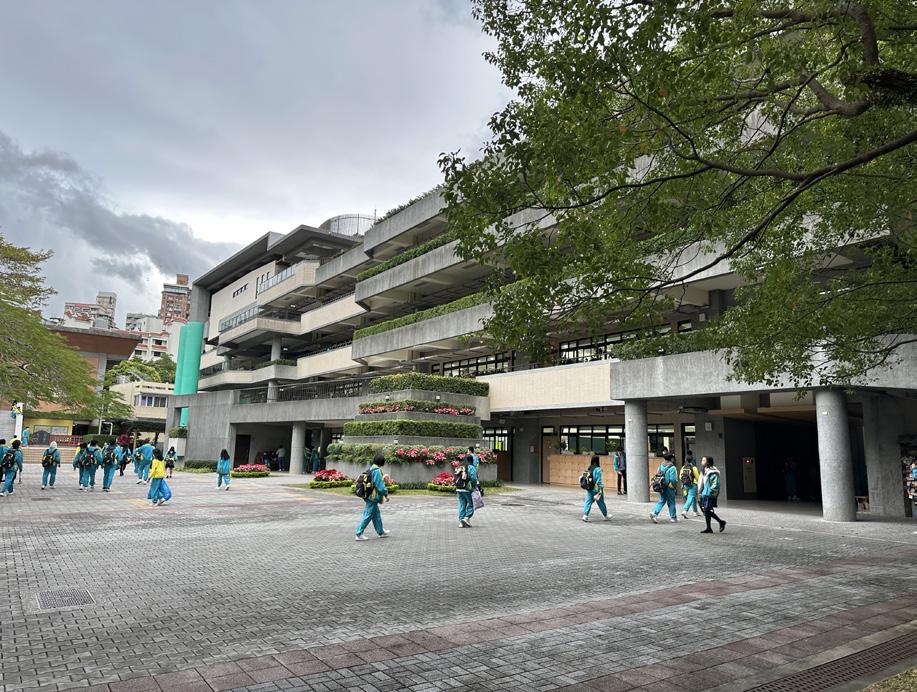
In the sprawling urban landscape of Taipei City, the intimate everyday bustle captivated my attention— and it felt like I was part of it.
beautiful green hills of Yilan. This refreshing change of scenery was an experience steeped with culture, with highlights of making scallion pancakes from scratch and releasing a fire-lit lantern into the sky.
These moments, distinct from the urban rhythm of Taipei, allowed me to deepen my connection to Taiwan and its traditions. By the time I returned from the program, I had not only gained a more worldly perspective of living in a different culture but an expanded Mandarin vocabulary and increased confidence in my speaking abilities, too. Undoubtedly, this memorable and immersive experience shaped my interest in learning more about both Taiwan’s language and culture inside and beyond the classroom.
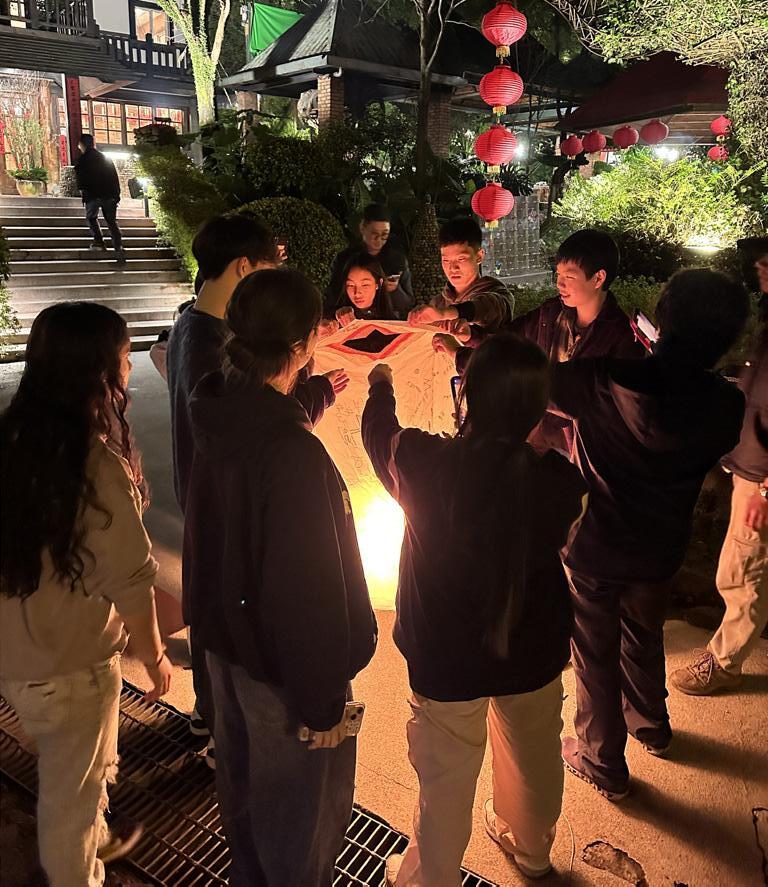


On its final day, the Japan exchange trip came face to face with the tragedy of Hiroshima
By Jackson H. Web Editor
On Aug. 6, 1945, the United States dropped the first atomic bomb on Hiroshima, Japan. While estimates are still disputed, the Hiroshima bombing took roughly 140,000 deaths by the end of 1945. Three days later, the United States took a similar toll in Nagasaki. A week later, Japan surrendered.
Almost 80 years later, 14 Nueva students, including myself, came to remember the losses the bomb caused.
The Upper School’s Japan exchange program is about to celebrate its tenth anniversary next year. The program connects Nueva students taking Japanese across skill levels with students at Doshisha Schools in Kyoto.
After attending school with our exchange students, Nueva students spent the final three days of the trip exploring Japan as a group. The final day of the trip was the somber visit to Hiroshima, where America dropped the first atomic bomb that brought World War II to a close.
The memorial museum at Hiroshima is exceptionally well done. I believe it is an obligatory visit for any American with the chance to go. This museum concerns itself less with the big-picture view of the war, where individual people’s tragedies become
nationalized statistics, but instead painfully recalls the devastation and breaking of hundreds of thousands of families.
This museum moves you to tears. There are only so many burnt and warped personal belongings, only so many letters to family, and only so many untreatable chronic illnesses, that one can process. It is a memorial to the parents left childless and the children left orphaned.
The most striking experience that day was meeting with a hibakusha (survivor of the atomic bomb). That morning, we heard from Kiyomi Kono, who shared with us her story and drawings of venturing into Hiroshima the day after the bombing to find her two sisters, who both survived.
Kono, who is 94 years old but to my eye looks no older than 70, has now spent decades telling her story at colleges and museums across the world, working to ensure the bombings are never forgotten. It is a personal legacy I marvel at.
Survivors of Aug. 6, 1945, went through indescribable losses and unspeakable pains that lasted the entirety of their lives. What I am most in awe of, then, is the way that the
community of the bombings’ survivors (about 100,000 hibakusha still survive today) have spent the past eight decades working towards the abolition of nuclear weapons and the creation of peace.
The extraordinary rebuilding of Hiroshima was truly something to behold, and we can only hope this community’s lasting wish—“No More Hiroshimas”—will be granted by the future generations obligated to remember it.
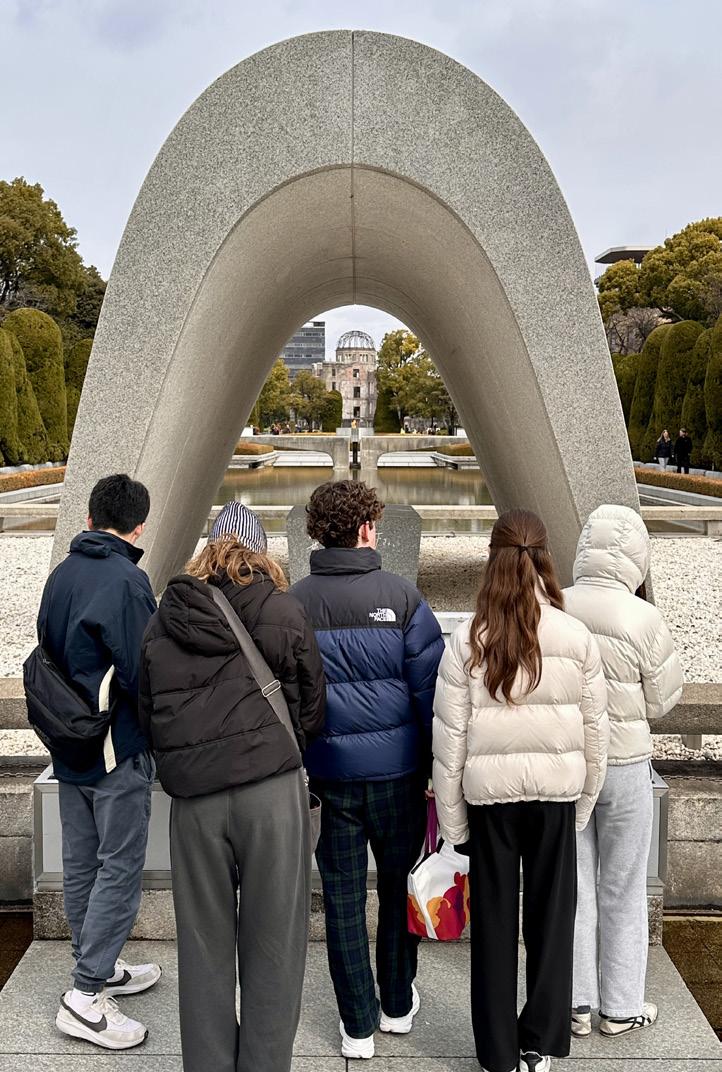
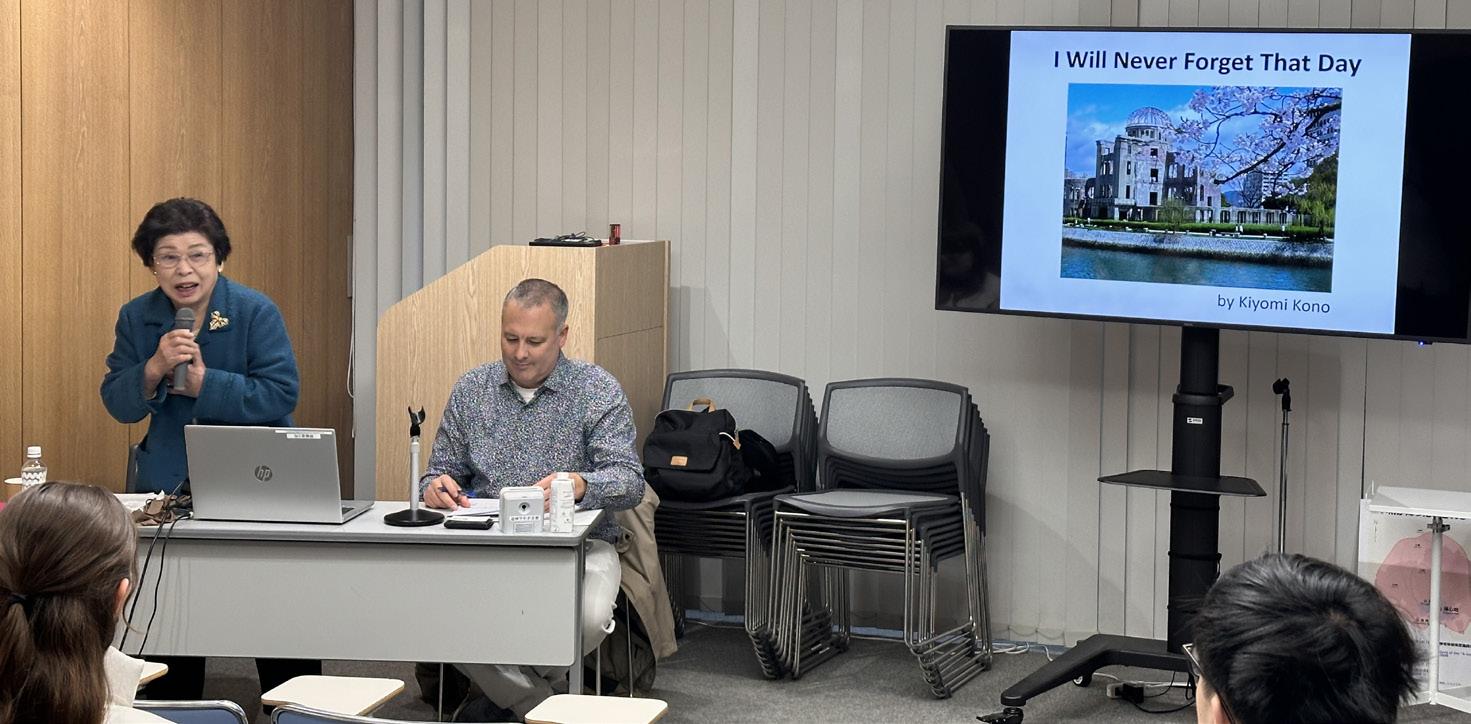
For Lucas T.’s ’28 Quest, he has built an electric surfboard, stemming from a love for the open water. Unlike a typical surfboard, which requires surfers to physically paddle out to waves, his board is propelled by a box attached to the object. Inside the box lie the motors, batteries, and controllers necessary to propel it. To connect the box to the surfboard, Lucas cut out part of his surfboard and glued the box on. As the container is constantly submerged, it is essential that the container sealing these devices is waterproof, which has proved to be a difficult task and therefore consumed a considerable amount of time. But, as a longtime surfer, Lucas was up for the challenge.


By Senna H. Staff Writer

Lucile O. ’27 and Clara B. ’27 are designing a gnome-themed escape room. As avid escape room fans and puzzle design lovers, they knew that this would be the perfect Quest–as for the theme, they were inspired by Lucile’s garden gnome earrings while coming up with their initial idea. Making an escape room is not as easy as one may think. The challenges can’t flow linearly, as multiple participants need to have a task to do at any given time, but they still must fit together thematically and sensically. They also have to give players just enough information to solve them while being appropriately difficult. You can try out some of their puzzles at Expo!
By Alexis C. Web Editor
For 100 days, juniors Senna H. and Mylie
M. are trying to get rejected. Inspired by Jia Jiang’s TedTalk, “What I learned from 100 days of rejection,” and with college application season approaching, Senna and Mylie wanted to get familiar with the feeling of rejection.
On the first day, they went to a fire station and asked to slide down the fire pole, feeling certain of the response they would receive.
“They said we couldn’t slide on the fire pole, but they gave us a tour of the station.
They let us sit in the driver’s seat [of
challenging experiences. During particularly stressful times, such as college application season, it’s valuable for students to have resilience.
“There are lots of choices that you do get to make when you apply to college, but students feel very keenly about the choices that they don’t get to make, and it’s an especially unfamiliar experience for Nueva students, I believe,” said Associate Director of College Counseling Paul Gallagher.

“‘Entitled. Soft.’ I've heard it all. I don't think it's true.”
But Gallagher doesn’t believe that college rejections are representative of student resilience. “‘Entitled. Soft.’ I’ve heard it all. I don’t think it’s true,” Gallagher said. “[Nueva students] are very adept at naming emotions that they’re feeling, even complex emotions…and they’re also very comfortable speaking with adults. I think those are the two differences that most impact the way that they cope with being denied an opportunity.”
To Upper School SEL teacher Sean Schochet, resilience means facing obstacles and coming out having learned from the
“We could learn strategies to build resiliency, like managing emotions, engaging
Zach M. ’26 motivation for this Quest comes from a previous failure. In eighth grade, he attempted to make an ion engine that didn’t run, and this year’s Quest provided him the opportunity to try again. After enlisting Max K. ’26, the duo began working on the engine, which is a bladeless fan with no moving parts, using two exposed parts with high voltage to accelerate air. These thrusters are used on spacecraft (on a much larger scale) with xenon for a steady, slow acceleration. Though this sounds difficult, these engines can be anything from some cans and a transformer to the complex ones NASA uses for spacecraft. Zach and Max falls on the simpler end of the spectrum, modifying a model off of the Plasma Channel on YouTube. Zach’s words to the Expo-goers: “It's not as hard as it sounds!”
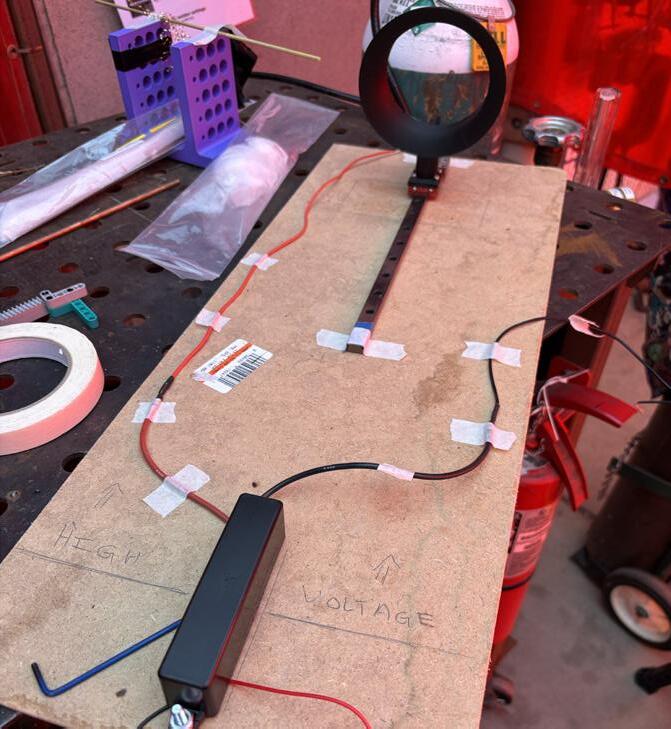

Learning the Great Highland bagpipes was originally a hobby Eleanor A. ’25 picked up for fun. She started out last summer on a chanter, the pipe of the bagpipe, before trying out the real instrument. She then began playing with the junior Prince Charles Pipe Band and performed at Coffeehouse in March, both of which enforced her commitment to the instrument. For her, learning the bagpipes has evolved from a yearlong project to an activity she wants to pursue past Expo.
The instrument is quite difficult–the music theory is complex, and requires a lot of precision and practiced technique that often go unnoticed by those who do not play it. “It's very difficult but it's [also] such a niche that people are very supportive and helpful if you want to learn more,” Eleanor said. She will be performing the instrument and talking about her process at Expo, so be sure to check her out.

in positive self-talk, coping with mental health challenges, and fostering strong relationships. However, the best way to learn to swim is by getting in the deep end,” Schochet said. “We learn to be more resilient through experiences that force us to overcome adversity.”
For Nate B. ’26, debate has helped him wrestle with his disappointment and use it for inspiration. In the spring of 2024, he faced a challenging debate season, culminating in one especially disappointing tournament. “It was really rough because it was a tournament where a lot of our teammates were having a lot of success, where we just kept losing,” Nate said. “We [realized] we have to actually put in the work to do better.” By the next tournament, the Tournament of Champions, he and his partner made it to the semifinals.
And sometimes, beyond winning, the act of being resilient is valuable itself. In his sophomore year, Leo S. ’25 invested time into building an e-commerce store, selling jewelry online. “Boom. No sales. It was a complete failure, which is horrible,” Stoll said. After taking a step back, and trying five more times, the business still failed to take off.
For Leo, the takeaway was more than persevering through struggles. “It was a great exercise in creativity, building things from the ground up, learning what I value and how to spend time well. There’s a lot of small lessons, even in that failure.”
From little failures to large ones, resilience only grows. “Before [100 days of rejection],
thing because I was afraid of failure,” Mylie said. “This pushing me out of my comfort zone has helped a lot. This year, I applied to a lot of summer programs, internships. I’m pretty proud of myself.”
According to Upper School Counselor Sydni Marmor, everyone practices resilience differently. “The heart of resiliency is to be curious about your experience and understanding of those moments of grit and struggle. There will be moments where you are incredibly resilient and moments where you are not, but both are equally important,” Marmor said.
Marmor believes that resilience can’t be
“The heart of resiliency is to be curious about your experience and understanding of those moments of grit and struggle.”
quantified, and isn’t a checkbox to fill. “It’s not whether Nueva students are or aren’t, but whether Nueva students slow down enough to acknowledge that they are.”

Continued from Page 1
For the admissions team, understanding andFor the admissions team, understanding and accounting for these differences in the applicant pool begins with transparency.
Director of Admissions Melanie León noted how affording a Nueva education is an open conversation from the very beginning of the admissions process.
“In [all panels and information sessions], I’ll introduce our financial assistance program so that prospective families with limited financial resources won’t immediately feel the need to rule out the school,” León said. “Instead, our hope is that they can go through the self-selecting process to think about whether Nueva would be a good fit.”
Concurrently, in THRIVE, a program for students from historically underrepresented backgrounds—which may include students who qualify for a certain degree of financial assistance—explicit talk of wealth and privilege might emerge. Some of the group’s conversations are in the context of adapting to class differences new to students.
“If this is your first time in a private school environment, it's definitely a different world,” said Director of Equity and Inclusion Shawn Taylor. “I think that you have to become fluent in all the nuances of that community to feel like you’re a part of it.”
Various Nueva initiatives also seek to provide equal opportunities for all students. For instance, the Internship Program, available to all 10–12th graders, increases access to internships that might otherwise require a connection or referral. Students who receive 50% or more financial assistance may also receive wages for a paid internship through Nueva—even if the employer does not pay for it.
“What Nueva has done is try to provide support in all aspects of the Nueva experience so that students receiving financial assistance never have to shy away from participating in something because of the cost of it,” León said. “I think that can move us forward in terms of hopefully taking anxiety away from being a family who receives financial assistance.”
The financial assistance program serves 195 students across the three divisions, roughly 20% of the student body. With approximately 7.5 million dollars committed to the financial assistance program for the 2024–25 school year, support varies greatly.
But beyond just being able to afford a Nueva education, the reality of what it means to be a student receiving financial assistance can be felt in the social fabric of fitting in.
Whether it’s being able to call an Uber to weekend hangouts or choosing the restaurant for a meal, there are plenty of social interactions where the socioeconomic differences between peers become more apparent and keenly felt. These aspects are not strictly school-related in the academic sense, but are still a part of one’s experience as a Nueva student.
Brenna believes that the observed socioeconomic differences are not inherently bad, nor worth hiding.
“At the end of the day, I don't think that it matters as much as it seems,” Brenna said. “I think there's a lot more worries about judgment than actual judgement around class.”
For Gemma M. ’28, her worries around being judged are reflected in her unease in situations where her socioeconomic status may be revealed. She described the
apprehension she occasionally feels when being driven to school by her older sibling.
“Our car is not the most flashy—it sometimes makes a noise when you turn,” Gemma said. “I know it doesn’t represent me and that it’s just a vehicle I’m in. But sometimes when I go to extracurriculars, even though I know I shouldn’t, I’ll ask to be dropped off farther away.”
Wendy E. ’26, a student on financial assistance, believes that this unease may be related to a general discomfort around entering a well-resourced private school environment like Nueva, which can be a uniquely selfconscious situation for first generation college and/or low income (FGLI) students.
Having come from a different middle school, she noted how some of the privileges her peers possessed seemed bewildering at first.
“As a student on aid, [I know] it’s easy to feel unfit here because you're not as wealthy as a lot of your peers. But then going back to your normal socioeconomic environment, you might also feel unfit because you're still getting these privileges and opportunities from a wealthy place like Nueva,” Wendy said. “The back and forth kind of creates a paradox [of] who you actually are.”
For Aiken C. ’27, a student on financial assistance who joined in sixth grade, moving between vastly different socioeconomic environments has made him more fluent in code-switching; the differences in his behavior manifests in the way he talks about money. With old friends from the public school he attended before Nueva, he will casually reference his socioeconomic background and upbringing in conversation. At Nueva, he simply does not mention the subject.
“I try to keep away from it—not because I think that people won't understand or because they’ll be snobby, but because I can't relate to them as much about it,” Aiken said.
The reluctance of students to reference their class is not just a result of self-inflicted judgment—insensitive or presumptuous comments have also shaped their discomfort. Aiken recalled hearing peers refer to poor San Francisco residents as unintelligent and drugaddled at school.
“As someone from a less well-off city neighborhood, it hurt,” Aiken said.
“There’s a price tag to some interactions, and we’re not always as mindful or accommodating as we could be.”
Wendy has faced similar moments of discomfort, such as when she heard peers laugh about kids they were tutoring as part of Peninsula Bridge, a local organization that helps first-generation, low-income students to achieve college and career success, then refer to being a TA as an experience purely for listing on a resume.
“I am part of Peninsula Bridge,” Wendy said. “I'm very much one of the students that

you could have been helping.”
Another time, she recalled mentioning how she wasn’t sure if her financial assistance covered trips expenses—and if so how much—to a friend. A peer overheard and remarked, “Oh, so I’m basically paying for you, then?” Wendy was not sure how to immediately respond.
For Aiken, these kinds of comments are difficult to call out, given the lack of any overt malice.
“I’ve never heard someone being made fun of for being poor. It’s more comments with these undertones,” Aiken said.
Still, no matter how subtle, comments create culture. Uncomfortable moments inform conversations and the reluctance around talking about financial assistance, and extend towards shaping the way wealth and privilege is generally discussed.
Upper School Head Liza Raynal has heard various jokes about the privileges students possess (such as multiple properties), in the form of casual teasing between friends with a self-deprecating tone.
“Jokes are good in that they diffuse tension. But I think jokes don't allow for the nuance of how complicated it can be to be able to be here,” Raynal said.
Miriam H. ’27 has observed how jokes that reference supposedly wealthy individuals become gossip, with a similar lack of nuance.
“People’s wealth is talked about more behind their back than to their face. I’ll hear whispers of, ‘oh, this person's really wealthy.’ It becomes a character trait, almost,” Miriam said.
Ayaan M. ’26 has noticed similar conversations—as well as the possible causes for the rumors: his peers’ casual mentions of international weekend trips and luxury cars.
“ I know people that will say, ‘oh yeah, I just did X and Y for the weekend,’ or ‘just went to X on vacation and bought all this,’” Ayaan said. “I'm made well aware of people's privilege and wealth when they talk about their life.”
Ayaan emphasized how these mentions of privilege are not intrinsically adverse on their own. However, their constancy can impact whether expensive possessions or experiences are considered to be privileges, or normal.
Evan W. ’26 described a custom he’s seen with many of his peers, where students will buy or be gifted a brand new car immediately after getting a driver’s license. As Evan went to a public middle school with students from mostly middle-class backgrounds, he was surprised how his time at Nueva made the phenomenon seem almost ordinary.
“From some of my friends who are a bit older and go to other schools, I know this is not something that happens really outside of here,” Evan said. “But you wouldn’t know that at Nueva. I get to school and see the cars, and I feel like it’s normal after three years here.”
Evan's experience speaks to the broader expectation of wealth, which many students have noticed, regardless of their socioeconomic background and how long they have attended the school.
Nathan S. ’25, coming from a public elementary school and private middle school, wasn’t quite sure whether to expect students with similar socioeconomic status or not, as well as what the overall wealth distribution would be like. This uncertainty was quickly amended.
“Once I walked through the doors, I got the general impression that everybody was
of a higher socioeconomic class than me,” Nathan said. “Then again, because people don't really talk about it, I'm not sure how accurate of an impression I really have.”
Some students attributed these impressions to a lack of conversations that explicitly address money, even in contexts where the subject emerges naturally.
Aryan M. ’25 described the cyclical nature of how a discomfort to discuss money and assumptions around wealth interact.
“It’s tough because of our general community demographic and the fact that we are a private school,” Aryan said. “If everyone thinks everyone’s coming from the same rich background, school can become an environment that doesn’t exactly encourage talking about [wealth].”
In the times where wealth or socioeconomic differences have come up, Aryan has found value in addressing them with his friends. He characterized the conversations as generally illuminating, but rare.
Nathan's experience has vastly

ETHAN HUYNH
BY
differed from that of Aryan's. The few conversations Nathan has noticed were completely private, often occurring between close friends. Still, whether discussing fees for a concert or gas for a road trip, the atmosphere was somewhat uncomfortable.
“In my experience, it's something that people avoid talking about,” Nathan said. “It can get awkward when it’s brought up.”
In that awkwardness, there is the potential for hurt—especially alongside the intersection of privilege, assumptions, and shame.
Ayaan noted how it can impact social lives, pointing to activities that require significant expenses, like a trip to TopGolf, or eating at the mall after school every day.
“ Classism at Nueva is not necessarily malicious: it’s subtle, and can be exclusionary. There’s a price tag to some interactions, and we’re not always as mindful or accommodating as we could be,” Ayaan said.
Patrick Berger, economics teacher and 9th grade co-dean, has made a conscientious effort to have frank conversations around privilege and wealth with his students.
During a recent advisory, a conversation about the future devolved into worries about getting a job without some specific college acceptance. Berger eventually suggested his advisees think about the privileges implicit in those worries.
“I got pretty exasperated after 20 minutes of these kids telling me, ‘my life


will be over if I don't go to Harvard,’ and ended up just telling them to look around at the environment they’re in,” Berger admitted. “Because even if we deny it or don’t talk about it, this place is a powerful network into positions of power and privilege for any high school student to have.”
Berger characterized his tone and the conversation as unusually blunt. Typically, he might make a lighthearted joke about Nueva privileges and resources students have seemingly grown accustomed to, or embed issues (such as rent control, or long-term environmental concerns in low-income neighborhoods) into his lessons that might not be immediately relevant in students’ lives.
“I was able to start a conversation this time because I'm very comfortable with these kids. But it’s such a tricky subject to navigate as a school,” Berger said. “If people walked around advertising their income status and the donations their parents made, that would be [odd.] And if they walked around with absolute silence and denial about either of those things, that would also be strange. Where do you find that balance of respect and acknowledging

20% of Nueva students received financial assistance in the 2024–2025 school year.
privilege?”
Director of I-Lab Angi Chau has attempted to find that middle ground. As a Nueva parent, she has encouraged her son to remember his audience and think about intentionality in talking about nice gifts or trips with his friends.
“There’s a difference between sharing cool things in your life and flaunting your privilege that I try to have an intentional conversation with him about,” Chau said. "We talk about, how do you think what you want to share might make your friends feel? Might it make anyone feel sad or left out?"
Yet, Dean of Students Jackee Bruno also emphasized how socioeconomic differences are something that students will be expected to encounter.
“In college, navigating the diversity of my friends and peers’ backgrounds was important,” Bruno said. “And in my life now, it’s still relevant.”
By acknowledging these disparities in high school, students get a chance to learn to navigate them with appropriate respect and tact.
Instead of trying to hide or be self-conscious about privilege, I-Lab Teacher and 12th Grade Dean Morgan Snyder highlighted how moving towards action can be meaningful, especially in a new environment where work around reconciling privilege can occur.
“I want my students to not get stuck in that self-consciousness about privilege. Instead, I like to say: What will your piece of service look like?” Snyder said. “Go out there and learn from people who have actually been working on those problems for a long time. Because teachers [on their own] can’t help you translate an intention to do good or an understanding of systemic injustice into actual action.”
Meanwhile, history teacher Tom Dorrance, who is also a Nueva parent, expressed concern over how an absence of
teacher guidance may contribute to an unspoken assumption that every student is wealthy.
“I think, as staff, we keep class in the shadows because we don't want anyone to feel bad about their class status,” Dorrance said. “But perhaps we almost implied that then students shouldn't talk about their class status, and made financial assistance or a working class experience something to hide—rather than just a reality that is just as normal as being in a position of privilege.”
To combat such an implication, Dorrance suggested setting up a basic familiarity with language regarding class and inequality.
“We’ve learned some vocabulary on what it means to be an upstander or ally, and talking about microaggressions. But we just don’t have that toolbox to talk about class,” Dorrance said. “If this is a subject that we really want to start taking on, I think we've got to start there.”
To Ayaan, there is no perfect, systematic solution to prevent every inconsiderate comment or awkward moment. Rather, he believes focusing on the interpersonal aspects of the issue is where real change can occur.
“As people, perhaps we just need to talk about privilege and wealth more,” Ayaan said. “And in those conversations, we should be more mindful and think about the fact that one fifth of us are on financial aid, and the implications of that.”
And if that mindfulness falters, Rohan K. ’26 has some suggestions. As a student receiving financial assistance, he has generally been frank with his friends and peers about that fact throughout the seven years he’s attended Nueva. Although the matter has typically been met with support, he has also learned how to mitigate any uncomfortable moments.
“If someone judges you for being on aid, then maybe you don’t want to hang around that person anyways, or maybe you try to have a conversation and call them out,” Rohan said.
In a similar vein, Brenna has refused to be ashamed about being on financial assistance. She has developed her own simple approach to mitigating any embarrassment for herself or others.
“You can’t change what other people think, you can only really change your feelings. That's my philosophy,” Brenna said.
Taylor believes that
accountability is key to building a better community overall. He hopes to build up a baseline level of comfort for being gracious and firm with asserting boundaries around any insensitive comments or judgement that comes up.
“Let’s be okay with saying: We don't do that in our community here,” Taylor said. “At the same time, it’s okay to [make mistakes] and be raggedy as long as you’re not being mean.”
“I think that you have to become fluent in all the nuances of that community to feel like you're a part of it.”
To Taylor, balancing accountability with allowing people to fumble and be awkward fosters an environment that welcomes dialogue. Paul Gallagher, 11th grade dean and Associate Director of College Counselling, similarly emphasized the importance of being comfortable with the uncomfortable moments that may emerge.
“Whenever you're in a diverse community, I think it's inevitable that some people's boundaries are tread upon. But I hope that there is a strong enough foundation of trust and grace that people feel [equally] comfortable calling someone out or apologizing,” Gallagher said.
Some students have already started to do so, simply by
opening up the conversation around money. In getting more comfortable with the subject, students can become more comfortable with each other, and build that foundation of trust.
Recently, Nathan's friend group discussed finances for their senior trip, a conversation that made them explicitly address socioeconomic differences.
“There is a diverse range in terms of what people can and want to spend [on our trip]. Now that's been something that took us a while to talk about, but there is real use to these conversations,” Nathan said.
In addition, Rohan's open approach to financial assistance is another step towards shifting the culture—though he acknowledged the very real worries other students receiving financial assistance may possess.
“I get that having people know is a scary thing,” Rohan said. “But I think we should at least feel more comfortable [talking about it]. Maybe it sometimes seems like no one else is on financial aid, but you’re really not the only one.”

Nueva’s queer community weighs in on
anti-trans legislation
By Senya S. Staff Writer
In the first three months of the Trump administration, anti-LGBTQ legislation has risen drastically. In his first term, President Donald Trump has enacted more anti-queer legislation than any previous administration. Since taking office for a second term, 32 state-level bills targeting the trans community have already passed. President Trump also signed a number of executive orders, including one declaring that there are only two sexes, another banning federal funding for youth gender-affirming care, and a third prohibiting trans people from serving in the military. Although California is unlikely to adopt similar legislation and Nueva has reaffirmed its values of belonging and inclusion, this national wave of anti-LGBTQ legislation has very much impacted the queer—especially trans—members of Nueva’s community.
She/They
Tate R. ’26 expressed “a complete and utter lack of surprise” at the recent rise in anti-trans legislation. As a junior, Tate feels that she has to be careful when considering possible colleges.
“College-wise, I'm restricted to, like, seventeen states that I'd be comfortable going to. It's made applying to colleges around here a lot more appealing because I just know they're going to be relatively safe,” she said.
More urgently, Tate is concerned about her access to hormone medication being potentially revoked. “I think that [I may lose access] in the next year sometime,” she said.
Generally, Tate feels that the recent rise in anti-trans legislation will have negative impacts beyond the trans community in America. “We're going to see that trans people with the means are going to move to countries that are more accepting. I think that will lead to a brain drain in
some industries. I don't think it'll be enormous, but it will involve some fairly important people going to other places. And obviously that'll hurt the U.S.,” she said. “I don't think people realize how important trans people in the organizations that they already operate under are until they're not there.”
She/Her
Andromeda W. ’26's first reaction to the change in administration was one of concern. “I feel like half of me was like, I need to get out of this country,” she said. “But the other half of me is like, it's okay. I'm in California.” Andromeda also expressed apprehension at how far the Trump administration's anti-trans legislation could go. “I think one of the scary things about this current time period is
how little we know about what's legal and what's not and what Trump's power is actually able to do,” she said. “Even though he's doing things that are technically illegal, how much will people push back against him?”
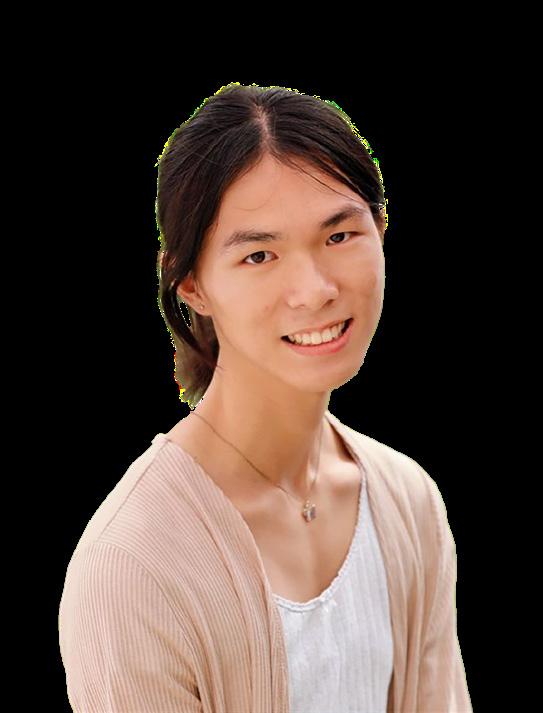
Though disheartened by the frightening possibilities of the administration, Andromeda hopes that the government’s checks and balances can help resist further anti-trans legislation. “I'm hoping that the Supreme Court or even lower courts can take action to keep the government more in check,” she concluded.


She/They
Aurelia F. ’27 has gone through extensive preparation in reaction to the current political climate: “Depending on how extreme the legislation gets, my family has had conversations about how there may be a need to move or to reschedule things,” she said. “I've been in communication with my gender therapist on certain medication I could use that would last for two or three years and pause any changes so I wouldn't decline without access to hormones.”
In the face of an alarming rise in anti-trans legislation, Aurelia appreciates the strong community of trans people in her life more than ever. “As someone who's very publicly out as trans, I've been able to support


They/Them
other trans people going through their journeys. Especially with these tumultuous times happening, I'm able to have a large network of friends of friends of friends who are trans,” Aurelia said. “One of the most kind and beneficial things in the trans community is how inclusive people are and how trans people help other trans people, given they understand the experiences and difficulties they've gone through and know how best to be kind and helpful.”

Aurelia said that community is currently more important than ever in the wake of recent anti-trans legislation: “Community is all that's left. It's all that we can lean on. It's one of the most important things that is central to the trans community as a whole,” she said. “The idea of everyone is unified together by these things. They're not the same labels, not the same experiences. Everyone's unique in their own way, but there's still underlying factors that connect us all.”

To Emily M. ’26, recent queer-trans legislation has felt like a huge step back: “It feels very much like there was a lot of progress made and that it’s all very quickly being torn down,” they said. Emily added that they, along with a small group of friends, plan to host a rally in response to the recent political climate with the goal of protesting the impacts of recent anti-queer legislation on the youth: “[Our] long-term hopes are—especially since a couple of us have friends outside of the state and around the country—[to find] a way to reach out to people in differ-
ent states and organize a walkout.” The group wants to make a statement to the government: “You are actively harming the youth and thus the future of this country.”


By Natalia R. Staff Writer
At Nueva, competition-based clubs are abundant: MUN, public forum and parliamentary debate, mock trial, robotics. One that students may not have heard of is the Future Problem Solving Team.
The team’s student coaches Vickie H. ’26, Aurelia F. ’27, and Lucile O. ’27, used the first few weekly Friday meetings to introduce the Global Issue Problem Solving Competitions (GIPS) to new members. Then, before the actual competition starts, two practice problems were given to participants. This year, the practice problems evaluated the different ways food security and rising sea levels might affect humanity in the future. The teams submit their practice problems in an online document called a booklet. Booklets are then scored by Futures evaluators, who also give them feedback on each step.
Once done practicing, the Futures members will tackle the qualifying problem. They can compete as individuals or in teams of 2–4 and are given two hours to complete a six-step process to find a solution. The topic of this year’s qualifying problem is how the agricultural industry will adapt to a growing population.
The first step of the process is to identify 16 challenges spanning multiple categories within their problem. For instance, each participant considers what hurdles government, science, and ethics each pose on the given topic.
The second step is selecting the main
underlying challenge, which Futures team members will concentrate their focus on for the remainder of the event.
For step three, students brainstorm any solutions that would take care of at least one part of the problem. In steps four and five, competitors set criteria for their solutions to rank them, then decide on the most promising solution.
The last step is developing an action plan. After completing these steps, Futures members may optionally showcase their creativity by pairing their action plan with an imaginative production. Lucile said the final production can help ease tension at competitions.
“You’re making a fool of yourself in front of everyone, and that definitely relaxes people,” Lucile said. “You do the serious part and then you have fun with all the competitors.”
All individual competitors will move on to the state level after they complete the qualifying round, while the top 50 percent of teams in the qualifiers advance to the state competition. The top two teams in the state advance to the international competition.
“My team last year placed first in the state so we went to internationals in Indiana,” Lucile said.
This year, due to trips week and state coinciding, most Futures members will compete individually instead of in teams.
One concern Futures is currently facing is the lack of incoming teammates from the Middle School. While the Upper

School Futures team has Science Teacher Jeremy Jacquot as a faculty advisor, the MS team lost its advisor after the COVID-19 pandemic. Now, the Futures team does not have its previous pipeline of incoming, experienced freshmen.
The members that came from the MS team had comfort and familiarity with the team and were more likely to join over newcomers. The team went from around 25 members to eight after losing a presence in the Middle School.
“It’s kind of one of those vicious cycles where, if you have a small number [of people in the club] then you might have a few die-hards or a few people who are willing to take a chance and get invested,”
Jacquot said. “But to just start to build up to critical mass is hard.”
Another factor in the smaller size of Futures is other competition-based clubs.
“There’re so many other things available here,” Jacquot said. “When you have robotics and speech and debate and everything else, I think we often get overshadowed.”
Still, the team is hopeful for the future. They have been communicating with Middle School head Karen Tiegel to find potential faculty advisors.
“I can imagine that if there were demand at the Middle School, if they knew about Futures and heard how it works, that could help push it,” Jacquot said.
Although governments seem to be making an attempt at reform, citizens have yet to see an uptick in action
By Alvin Y. News Editor
After three months of deliberation, the Fremont City Council voted 4–1 for the city’s newest camping ordinance, passing one of the most restrictive laws targeting homelessness in the city’s history. The ordinance states that anyone who was caught camping on public property and those who “aided or abetted” homeless encampments could be arrested.
The Feb. 11 ordinance was immediately met with outrage and uproar, leading 25 unions of homeless advocates to sue the city for the ordinance’s broad definition of “camping” which criminalizes living outdoors in general. However, instead of revising the ordinance to the unions’ standards, the Fremont City Council only removed the clause about targeting organizations helping the homeless, claiming that targeting those who handed out essentials such as food and water was not the primary target.
The city’s decision to go through with the illegalization of homeless encampments was a culmination of California’s shift towards cleaning streets and removing homeless encampments.
Since 2024, the state has been taking strides against homelessness and clearing public spaces: from legal encampment removal to assisting cities’ supportive housing systems, elected leaders including Supervisor Matt Dorsey and San Francisco Mayor Daniel Lurie ran on addressing the homelessness crisis in their campaigns. However, some residents have not seen an increase in the enforcement of such policies and are concerned that there isn’t enough action taken.
“I would say on the side of the public, there’s definitely a lot of talk about helping the homeless,” said Brooks W. ’26, a San Francisco resident. “However, there isn’t the same amount of action that is being
discussed.”
In June 2024, the United States Supreme Court greenlighted and encouraged 10 West Coast states—California being one of them—to remove homeless encampments, marking one of the most impactful decisions on homelessness within the last decade. Additionally, Governor Gavin Newsom followed with an executive order encouraging city governments to follow through and initiate removals around the state.
“His recent Supreme Court decision was a pretty important step. California has been struggling with homelessness for 30 years,” Nate B. ’26 said. “Most of it is not people coming from out of state, as some people say, most of it is people from California.”
However, Nate, a San Francisco resident who sees an increased number of unhoused people in some districts and fewer in others, says enforcement isn’t working the way he wished it would.
“San Francisco is simultaneously too lax and too strict on homelessness,” Bomze said. “Although there is enforcement taking place, people are just getting shuttled around the city, rendering the enforcement useless.”
Many concerns centered around homeless encampments and street cleanliness stem from problems with shelters. Whether it's due to safety concerns, including theft, sexual harassment, or violence; a lack of support systems catered to individuals; exclusion of pets; or the lack of beds leading to overcrowding, roughly two-thirds of the total 187,000 unhoused individuals in the country live on the street according to the US Department of Housing and Urban Development. Additionally, issues with the layout of the land lead to increasing prices for building homes, leading to a limited number of shelters that can stay open.
Nate believes that individualized assistance and changes to the housing systems for everyone are crucial to solving

the crisis.
“We need to reduce redlining and difficult permitting processes that prevent housing,” Nate said. “Ultimately, it’s a whole lot worse than the historic character
"There's definitely a lot of talk about helping the homeless. However, there isn't the same amount of action that is being discussed among leaders."
of your neighborhood getting damaged.” Brooks, although believing this is the right step towards solving the crisis, is still skeptical of the effectiveness of implementation and hopes the city can take a stronger stance in preventing homelessness in the future.
“I do remain skeptical of its effectiveness—as evidenced by the consistent lack of implementation of policy in past years of other legislation—and in its implications for prevention measures rather than recovery measures,” Brooks said. “In order to end the homelessness crisis in the long-term,
we need to implement prevention measures aimed towards helping people, but in the short-term, this is a great step towards solving the issue.”
San Francisco Supervisor Matt Dorsey has already begun addressing the issues surrounding the lack of support in shelters.
On March 18, Dorsey and Mayor Daniel Lurie passed a law supporting homeless shelters that will provide over 1,500 beds for shelters, improve management services, and correct spending to maximize efficiency and supply support and accountability for the homeless. Nate has high hopes for the new legislation.
“I think Matt Dorsey’s plan is necessary for the city to create the possibility of making a meaningful dent in homelessness,” Nate said. “The city needs to incentivize people to stay in shelters, and they don’t work if people don’t want to use them.”
Although progress is slow, California has prioritized cleanups, expanding shelter capacity, and valuing individualized support systems for the homeless. Whether those efforts will materialize into real progress or remain just another policy push remains to be seen.
By Callum S. Staff Writer
Humor has constantly evolved since the dawn of time, a mirror to humanity’s ever-shifting culture, intellect, and sensibilities. But now, after ages of refinement, humor has hit a wall—or rather, it’s tripped over its own feet and fallen face-first into a slew of digital garbage.
“Brainrot,” the 2024 Oxford word of the year, has exploded across the cultural landscape, with its grip already tightening on the minds of the youngest Generation Alpha. It characterizes a new kind of content online so trivial, low-quality, and mind-numbingly repetitive that it feels like it's chipping away at your mental and intellectual state as you watch it.

You’ve definitely come across it before. Think words like skibidi, sigma, and rizz. These terms have become so pervasive that they’ve seeped into everyday conversation. Phrases like “what the sigma” or “skibidi Ohio rizz” make no logical sense, and that's the point. As these words grow increasingly popular, they lose meaning, becoming placeholders for just about anything else.
But these aren’t just words; they are the future of humor—a humor that has already consumed the newest wave of young people. In the coming years, comedy will no longer be about flair, timing, or punchlines; it’s about stupidity, repetition, and the sheer effortlessness of brainrot. Jokes won’t be crafted, they will be regurgitated, stripped of meaning, and tossed around for a quick laugh.
The shift is starting with our youngest gen-
eration. Two-thirds of Generation Alpha were exposed to tablets and other digital devices before the age of 5. For many parents, handing over an iPad is the easiest way to keep their kids entertained. But the result? A generation of extremely young children stumbling into the chaotic world of online content ruled by brainrot, whether they're playing Roblox, scrolling TikTok, or watching YouTube.
Their digital diet can range from garbled text chat slang to 70 part sagas about an army of toilets waging war on a colony of security cameras. I know—it’s dumb. When repeatedly consumed, these words and videos don’t just stay on the internet; they will invade the brains of these young people and influence how they talk, joke, and even think.
Brainrot’s popularity thrives on its absurdity and rapid evolution. To any sensible person over the age of 25, terms like “fanum tax,” “gyatt,” and “looksmaxxing” are baffling.
This senselessness is what makes brainrot universal—it doesn’t need wit, context, or even meaning to cross language barriers or cultural divides. Its ridiculousness speaks for itself, growing faster than traditional humor could, and that's exactly why it's taking over.
This isn’t just a shift in humor, it's a full-blown un raveling.
Young people are driving the
quick descent of true comedy. We have always been the ones to decide what's accepted, what’s trendy, and what’s worth laughing at. The issue is that brainrot isn’t teaching us to think creatively; it’s teaching us to find the lowest common denominator. As Generation Alpha matures, they’ll carry this brainrot-infused humor into adulthood, determining the future of comedy, media, and even how we connect.
It doesn’t have to be this way, though. It’s not too late to stop this and ask ourselves if this is the kind of humor we want to define us. What if humanity is wiped off the face of the earth, and the only evidence of our existence is a photo of John Pork, an anthropomorphic pig calling you on FaceTime?
As young people, we can look to the past and embrace the foundation of modern comedy, classics like Charlie Chaplin, Monty Python—or if you prefer contemporary humor— shows like Saturday Night Live, Key & Peele, or Curb Your Enthusiasm. And of course, comedians like Bill Burr, Dave Chapelle, Atsuko Okatsuka, Gabriel Iglesias, and Theo Von.

I could talk for hours about my favorite shows and comedians, but my point is, true comedy thrives on innovation, not redundancy. These shows succeeded by pushing boundaries. If we want humor that truly lasts, we’ll have to demand more than just recycled nonsense."
Humor should challenge us, test the limits of our creativity, and bring us together; it shouldn’t be a tool to diminish our intellect. The future of humor is regressing as we speak, and if we don’t act now, humanity will be doomed.
ART BY SENYA S.
internet rabbit holes.
By Margot S. Guest Writer
D’28 Natalia R. ’28 Senya S. ’26 Callum S. ’27
The Nueva Current strives to provide informative and impactful articles for our community. Our issues cover stories related to our school, the Bay Area, California, and other relevant spheres. We are dedicated to helping readers understand the ways in which we can all make a difference in the world around us.
The opinions expressed in The Nueva Current belong solely to the writers and are not a reflection or representation of the opinions of the school or administrators.

uring a week-long, technology-free school trip to the Tidelines Institute of Alaska last April, I lived in a cabin without any data connection. I realized something surprising–I didn’t actually need my phone. Before the trip, I’d fallen victim to habits of scrolling on Tiktok and Instagram reels for hours on end. I used my phone upon waking up, at breakfast, lunch, and dinner, while doing homework, and before going to sleep.
So when I got home from Alaska, I made a bold move: I switched to a flip phone. I got the CatS22 flip phone, a compact device with a 2.5” touchscreen and 16GB of storage capable of downloading essential apps (maps, messages, and calls), but too slow for anything else.
At first, the flip phone worked: my screen time dropped to nearly zero, and I enjoyed showing off my new device to curious friends. Without the irresist ible lure of social media, I could focus on school, extracur riculars, and quality time with friends and family. During class, I could sit through hour-long lectures without getting distract ed. On the Caltrain, I could enjoy the view outside the window for 30 minutes.
But after about a month, I felt myself regressing into old screen time habits. Instead of using social media on my phone, I spent my newfound time on my laptop browsing online shopping sites, binge-watching reality TV, and getting lost in
Even after downloading a Google Chrome extension to block sites like Netflix on my laptop, I found new loopholes and online distractions to keep myself occupied. That old, familiar feeling creeped back in—the stress of knowing I was wasting time on screens but was too addicted to stop.
I soon realized that my phone had never been the problem. I could always find a new distraction, and without self-discipline, I’d be stuck in an endless cycle. What made my time in Alaska so memorable wasn’t just my lack of
Without the irresistible lure of social media, I could focus on school, extracurriculars, and quality time with friends and family. During class, I could sit through hour-long lectures without getting distracted. On the Caltrain, I could enjoy the view outside the window for 30 minutes.

iPhone but also the lack of any technology, internet, or distractions in general.
Back in my daily life, it was
impossible to truly escape every distraction. Instead, I had to learn to develop self-discipline slowly and steadily.
To spend less time on my phone, I decided to spend more time doing things I was truly passionate about. However, I started small. Extremely small. For example, I’m an ice skater and wanted to start ice skating in the morning before school, to help start my day without a screen. Abruptly forcing myself into this daily routine would have backfired, so I instead started ice skating in the morning just once a week. I gradually increased the amount of mornings I ice skated and reached my goal. I believe that this mindset applies to breaking bad habits—you can’t change overnight, but you can definitely start small and build up gradually.
Now, don’t get me wrong, I still love watching my favorite reality television shows (especially Love is Blind and Shark Tank). The difference is that I can indulge in moderation without worrying about it taking over my time. And of course, I still overindulge from time to time, but I’m improving everyday.
I have now switched back to a regular phone. While the flip phone taught me a valuable lesson, it was too slow, and I now have the discipline to have an iPhone without getting too addicted.
This time, I hope to use my new time-management skills to enjoy social media and the internet in moderation. Despite what our parents like to claim, I have learned that the phone isn’t necessarily the problem but rather self-discipline and time management.
I hope you can learn from my journey and reflect on how to be present in your life–whether that means setting new goals, creating sustainable habits, or even getting a flip phone of your own. Though, keep in mind that it will take you 10 minutes to type and send a single text to your friends!
The Nueva Current is distributed to current and alumni members of The Nueva School community. Press run is 600 copies, printed by FolgerGraphics. Fonts used in Volume 8: Very Vogue, Seriously Nostalgic, Awesome Font, Glamour Absolute, and ITC Galliard Std.
The Nueva Current is a member of the NSPA and CSPA. NSPA Pacemaker Finalist 2020, 2022, 2023. Pacemaker Winner 2022. Gold Crown winner 2023.
QUESTIONS, COMMENTS, SUBMISSIONS
We welcome your voices. We accept photographs, letters to the editors, articles, illustrations, and other pieces of work. Please email us at thenuevacurrent@nuevaschool. org.
STAY CONNECTED
www.thenuevacurrent.com
Instagram: @thenuevacurrent
Twitter: @thenuevacurrent 131 E. 28th Ave. San Mateo, CA 94403
The Nueva Current welcomes comments and suggestions. We seek to publish corrections and clarifications in the subsequent issue. Please email any corrections to thenuevacurrent@nuevaschool.org.

Big Tech’s been right-wing.
By Jackson H. Web Editor
Elon Musk has spent the last three months waging a one-man war on the very concept of a functioning government and has won most of his battles doing so.
But the Tesla CEO-turned-economic wrecking ball has not been the only Big Tech leader who’s begun to shift right.
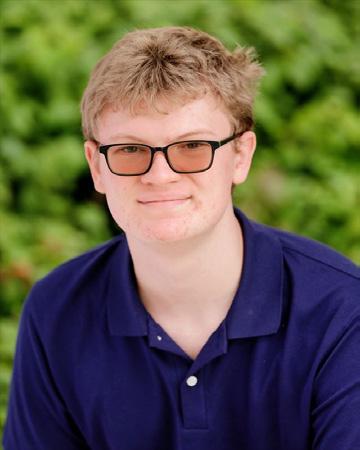
Meta founder Mark Zuckerberg got a perm and kicked off a tour of the right-wing podcast circuit. Other key figures, including Apple’s Tim Cook, Google’s Sundar Pichai, and Amazon’s Jeff Bezos, also made the pilgrimage to Trump’s inauguration and donated to the inaugural fund.
The rise of the right in the Bay Area may seem to have come out of the blue, but it really hasn’t. For many tech leaders, the marriage of convenience between Silicon Valley and the Democratic Party has outlived its utility.
Their covenant had begun in the 1980s. Quite a few young Democratic congressmen, seeking to modernize their image in the age of Reagan, came to adopt support for investing in and growing the high-tech industry as an economic pet issue. They became the “Atari Democrats.”
This arrangement was similarly beneficial for the young Silicon Valley startups. These firms relied on public funding and had good reason to fear the anti-science, deeply socially conservative Republican Party of the time as fundamentally hostile to growth in high-tech. And so, the Bay Area’s vote—and more importantly its big-dollar donors—became increasingly lopsided in favor of the Democrats.
Today, tech is no longer an edge market in need of government support to get off the ground. These companies are among the biggest in the world, and—with the exception of biomedical firms—their concerns have shifted from gaining research grants to continuing to dodge unionization, corporate taxes, and antitrust. The go-to party for that agenda is the GOP.
But the roots of this rightward shift go deeper than just the industry’s shifting material interests. The very core of Silicon Valley’s ethos is emulated in the President’s self-image.
The “Silicon Valley ethos” is built around the idea of the founding visionary and “disruptor” who chooses to “move fast and break” a given sector for the supposed
Two student perspectives on tech leaders' cautious embrace of Trump
Meta hasn’t always “disliked” DEI and democracy
The essence of Silicon Valley is un-Trumpian
By Kayla L. Opinion Editor
betterment of humanity, de spite the lack of any actual experience in the field.

In their private com panies, they are unac countable to sharehold ers or union reps. They are saving humanity either from overpriced bureaucracy or, in some cases, literal human extinction. Within their corporate realms, they are akin to dictators.
This sounds familiar.
Trump has proclaimed, both in his inaugural address and the recent State of the Union, that he was saved by God from assassination in order to save America. And while the religious and nationalist overtones may not feel like the pitch of a startup founder, there is no shortage of interviews where Musk articulates this same sense of predestined self-importance.



It was confusing—shocking, even—for me to watch Meta CEO Mark Zuckerberg and Alphabet CEO Sundar Pichai fall in line alongside Tesla CEO Elon Musk and Amazon CEO Jeff Bezos at President Donald Trump’s inauguration. The billionaires looked like they were reenacting “The Bosses of the Senate,” a political cartoon of 1880s industrialists fattened by engorged stomachs of money bags, looking down upon American senators.

If Trump is to be a “founder” in the lofty language of startup-speak, then America has become this firm’s latest acquisition. As such, it is time for the new ownership to cut corners, lay off, and “modernize” the government.
The Republican Party, now commandeered by Musk, has moved from calling for this coun try to be “run like a business,” as they have for decades, to saying we should run it like a startup. Saying America should be run like Ford Motors is one kind of cost-cutting cruelty, but saying it should be run like X is a whole other ballgame.

The “self-made” leaders of the tech industry are titans that Silicon Valley residents like myself have been conditioned to revere. They are the economic pillars of our region, and their excellence in higher education, entrepreneurship, the breaking of traditions, and the advancement of humanity have contributed to a local culture that inspired me to embrace similar values: lifelong-learning, innovation, bravery, and compassion.



This is the sort of management that Silicon Valley loves. These corporations emerged as apostles of “think different” in a revolution of efficiency against the old bureaucratic way of doing things. They are destined to outcompete and overcome.
And as the bureaucratic engines of the federal government have started to run too slowly, they too will be replaced in a fit of creative destruction that leaves behind—if Musk is successful—a country we cannot recognize.

To reconcile Zuckerberg and Pichai’s recent behavior with the famously well-educated and nonconformist Bay Area is a task that I have attempted and failed numerous times recently. The high-profile tech executives supporting far-right stances are without a strong historical president, and it’s not in Silicon Valley’s nature to support a president like Donald Trump. However, they do serve as reminders that our region can and must practice the freethinking culture that we preach.
The clearest difference between Silicon Valley leaders and the average Trump supporter is the education gap.
Except for the outliers, the computer engineers at Google, startup founders creating the next AI company, and legacy tech executives in Mountain View must have at least a college degree to climb the corporate ladder in Silicon Valley. In Palo Alto alone, 82% of adult residents have a college degree, which makes sense. Silicon Valley is overflowing with very well-educated people.
Meanwhile, just 37% of American adults have a college degree. And in 2020, almost all states below the nationwide average education rate voted for Trump. Furthermore, exit polls showed that Trump led among voters without a college degree by 10 percentage points, while Kamala Harris led college graduates by 21 points.
I do not mean to say that the divide in formal education creates any moral hierarchy in America. Rather, obtaining a college education can often open up one’s mind to new perspectives in and outside of the classroom. And while there certainly are well-educated
Trump supporters, I believe that this increased education can make it much more difficult to align with President Trump’s values and initiatives.
Another influential factor for Silicon Valley’s liberal leanings is its place within the larger Bay Area tapestry.
While the Valley is a bit more moderate than San Francisco’s progressive and unconventional culture, there are strong similarities across the Bay Area. For example, Silicon Valley companies such as Apple, Visa, Amazon, Pinterest, Roblox, and eBay presented floats at the 2024 SF Pride Parade, the world’s largest LGBTQ+ parade. Though they were absent this past year, Facebook and Google had participated in the celebration for years.
In the 2000s, a grassroots organization of queer Google employees, self-proclaimed “Gayglers,” was founded by former Google engineer Bennet Marks. The Gayglers and their heterosexual colleagues marched at SF Pride and parades across the country. Marks estimated that “in [the] enormous contingent of marchers, about half were straight supporters.” The connections between social justice and technological progress are undeniable in the Bay Area. Together, they form social progress.
I am proud that companies in our area were doing inclusion work—I know, with varying shades of commitment at first—decades before the BLM movement or Trump’s anti-DEI rhetoric came along. This is because we recognize that there is work to be done: we are not perfectly diverse or equitable yet. Engineers are still predominantly white, male, and straight. But a lot of them have been trying to get it right.
I dug up an old tweet from Zuckerburg about his parade participation alongside 700 Facebook employees in 2013. “I’m proud that our country is moving in the right direction, and I’m happy for so many of my friends and their families. #PrideConnectsUs,” he wrote. His words were pretty incredible, right? Zuckerberg was one of the first CEOs of a major company in the entire United States to publicly support the LGBTQ+ community. Though we cannot access Zuckerberg’s recently-baffling mind, I doubt that his support for the queer community was just for some personal economic advantage. I think he really believed in the social progress that his place of residence was at the forefront of.
So, Silicon Valley has not always bred Trump supporters like Zuckerberg and Pichai—Zuckerberg himself was, until very recently, opposed to the Trump agenda.
The implications of Silicon Valley’s history are important. The Bay Area is rife with bold and fearless innovators. They rebel against the traditional hierarchy that President Trump seeks to reinforce. And, at the crux of these companies’ past support for inclusivity was a mission for uplifting each other and the world.
Once we recognize our region’s foundational values, the next step is realigning with them. If the leaders of Silicon Valley take a stand for human rights, democracy, and freedom against the leadership in Washington D.C., they will not be blazing a new trail. Instead, they can run down a path that is already neatly paved by the history of their community.
By Jordan F. Staff Writer
While scrolling through social media, the two young-looking girls, no older than eight, doing skincare and makeup while sharing about their daily lives is an inevitable sight.

Those girls are Haven Garza and Koti Garza, stars of the TikTok account Garza Crew. With their mom Adrea Garza, they have amassed over five million followers, monetizing on the girls’ “preppy lifestyle,” a playful aesthetic with bright-colored clothes, and an emphasis on popular brands like Stanley and Aviator Nation. They publish one to two videos a day, including popular “get ready with me” videos while using products from Glow Recipe, Tower 28, e.l.f, and other viral beauty brands.
This seemingly strange sight isn’t rare. On social media, many kids as young as six are using the fancy bubble skincare headbands, clearing out Lululemon stores, and spraying Sol De Janeiro body mists.

Now more than ever, social media platforms like TikTok and Instagram have evolved into big marketing tools aimed at influencing young, impressionable audiences. This overcon sumption of advertising content is causing mass overbuying and producing many micro-trends—viral consumer behavioral fads that gain and lose popularity quickly.

This premature exposure to beauty standards, materialism, and more “grown-up” routines takes away childhood and replaces it with awareness of personal appearance and social status. With this, I fear that these kids are no longer satisfied with age-appropriate activities, and instead seek validation and aesthetic appeal that social media pop culture promotes.
This is in part possible because kids are getting devices at younger ages. A 2022 survey conducted by Stanford Medicine found that the average parent gives their child a phone between 10 and 12 years of age. Another study from Brown University showed that in 2015, only 11% of 8-year-olds in the U.S. had a cell phone, but by 2021, this increased by 30%. The percent of tween's phone ownership also increased by 43% from 2015 to 2021.
As someone who admits to being an overconsumer myself and has been influenced by social media, buying trending
BY JORDAN
clothes from stores like Brandy Melville and trying out the Glow Recipe Dew Drops, I recognize the amusement of these trends. However, the downside is clear: Kids are growing older faster, skipping a pre-teen phase, and diving straight into products they see older people use just because they saw it while scrolling through a phone they shouldn’t have.
This new widespread phenomenon of social media is shaping the younger generation like never seen before. Kids growing up too quickly is harmful because it can expose them to

peer pressures, and anxiety, and they don’t get to enjoy the “carefree” experience of being a child. In today’s society, there is often a lot of judgment that comes with being a teen and social media often perpetuates this, setting unrealistic standards and expectations. With their highly busy product-filled lifestyles, many beauty and lifestyle influencers normalize PR, massive hauls, and maximalist beauty routines that their young audiences inevitably seek to replicate. This Gen-Z-oriented promotion causes preteens to buy everything their favorite influencer uses, from $89 Dandy Worldwide hoodies to $39 niacinamide serums, even though many of the products these influencers are using aren’t intended for them. Why does a 9-year-old need “A-Passioni Retinol Cream,” a $76 product intended for aging skin?

This obsession has traveled all across social media, with posts of kids, aging 9–12, going into Sephora and buying hundreds of dollars of beauty products, known for being rude, and leaving samples destroyed, have gained popularity. This #Sephorakids trend has almost 13,000 posts.
The constant exposure to this content creates a space where pre-teens and teens feel pressured to engage in excessive consumerism to fit into the idolized versions of others they see online, which sometimes is manufactured for views and unrealistic.
Growing up, I often feel more judged than when I was a kid. It is almost as if now everything I do is being watched, evaluated, and criticized. Unplugging and enjoying your childhood is important because we can never get those stressfree days back.
To help this problem, I think it is important for parents to wait a little longer before letting their kids enter the digital world and encourage them to live their youth as long as they can.
By Raya I. Guest Writer
Nueva should reframe the way it teaches grammar so its students can become better writers and thinkers
Since I began to write—and even before that, when I was hungrily devouring every picture book you could throw at me—I’ve been attuned to the subtleties of just how one writes. This continued exposure to words has led me to feel confident in my writing abilities as a means to communicate my ideas clearly and concisely. To me, this is what writing does most fundamentally, and it is writing mechanics that allows this transmission of concepts to take place.

Having participated in many peer review workshops throughout my four years at Nueva, as well as witnessing the growing popularity of technologies like ChatGPT and Grammarly, I’ve come to believe that while Nueva sometimes succeeds in its exploratory, innovative approach to writing, it sometimes leaves students without the tools to express their complex and novel ideas.
My own experience in elementary school has furthered my belief that good grammar education makes a positive difference in writing development. I attended a small, fairly traditional private school through fourth grade that taught reading and writing through phonetics, grammar, and
repetition.
Even though this approach eventually left me bored and wanting more, I credit it with showing me the importance of the rules that support writing—rules that can be broken to creative effect, rules that have changed across times and cultures, but rules that also can mean the difference between a well-crafted essay and a confusing one, or a concise email and a frustratingly incoherent block of text.
In my experience at the Nueva Middle School, grammar is not formally built into the curriculum, unless a teacher takes it upon themselves to introduce the occasional topic. Instead, it is assumed that students are intuitively picking up grammar concepts from reading and writing.
What I’ve come to realize is that more explicit grammar instruction would not take away from Nueva’s curricular emphasis on critical thinking, growth mindset, deep analysis, or any other concept that our humanities teachers work so hard to instill in us.
In fact, grammar instruction would enhance all these learning goals, as the grammar problem is ultimately one of confidence: if you know how to manipulate language in the right ways, you will be able to form a clearer thesis and consequently defend it better, paving the way for the real writing to happen. Grammar is the
fundamental system of rules that renders all language either comprehensible or not.
This issue of not teaching grammar explicitly certainly isn’t isolated to Nueva. It stems in part from the way my generation interacts with and uses language: in fragmented and strangely captioned videos, online forums, texts, and the rest of the depths of the Internet. It’s hardly our fault that we barely read books anymore— everyone speaks Internet now.
And it makes sense that it is harder to learn grammar through pure exposure these days, since social media’s unconventional use of language is being thrown at us everywhere we look. The Internet also exacerbates the problem in another way: tools like ChatGPT and Grammarly serve as crutches that deprive students of the opportunity to learn grammar for themselves. Cheating ourselves like this goes against Nueva’s philosophy as it thwarts deep learning and eventual mastery through trial and error.
Grammar lessons have a bad reputation for being dry and boring, but I believe in Nueva’s capacity to make teaching grammar as fun, unique, and Nuevan as possible, just like everything else that we do. Grammar instruction should begin in the Lower School, the most crucial time for learning to read and write well; continue in the Middle School, formative
This issue of not teaching grammar explicitly certainly isn’t isolated to Nueva. It stems in part from the way my generation interacts with and uses language.
years for honing writing skills; and not be neglected in the Upper School, as students write full-length papers and prepare for the college application process and their lives beyond the classroom. This way, Nueva students will be well-equipped to pursue the true goals of writing: stating a claim and defending it, spinning an engaging story, writing a logical lab report.
The ability to write coherently, concisely, and grammatically correctly is crucial for everyone. No matter the profession, having confidence in our writing abilities will make us all better scientists, lawyers, activists, artists, speakers, citizens, and humans.
By Marcus H. Guest Contributor
By Anwen C. Staff Writer
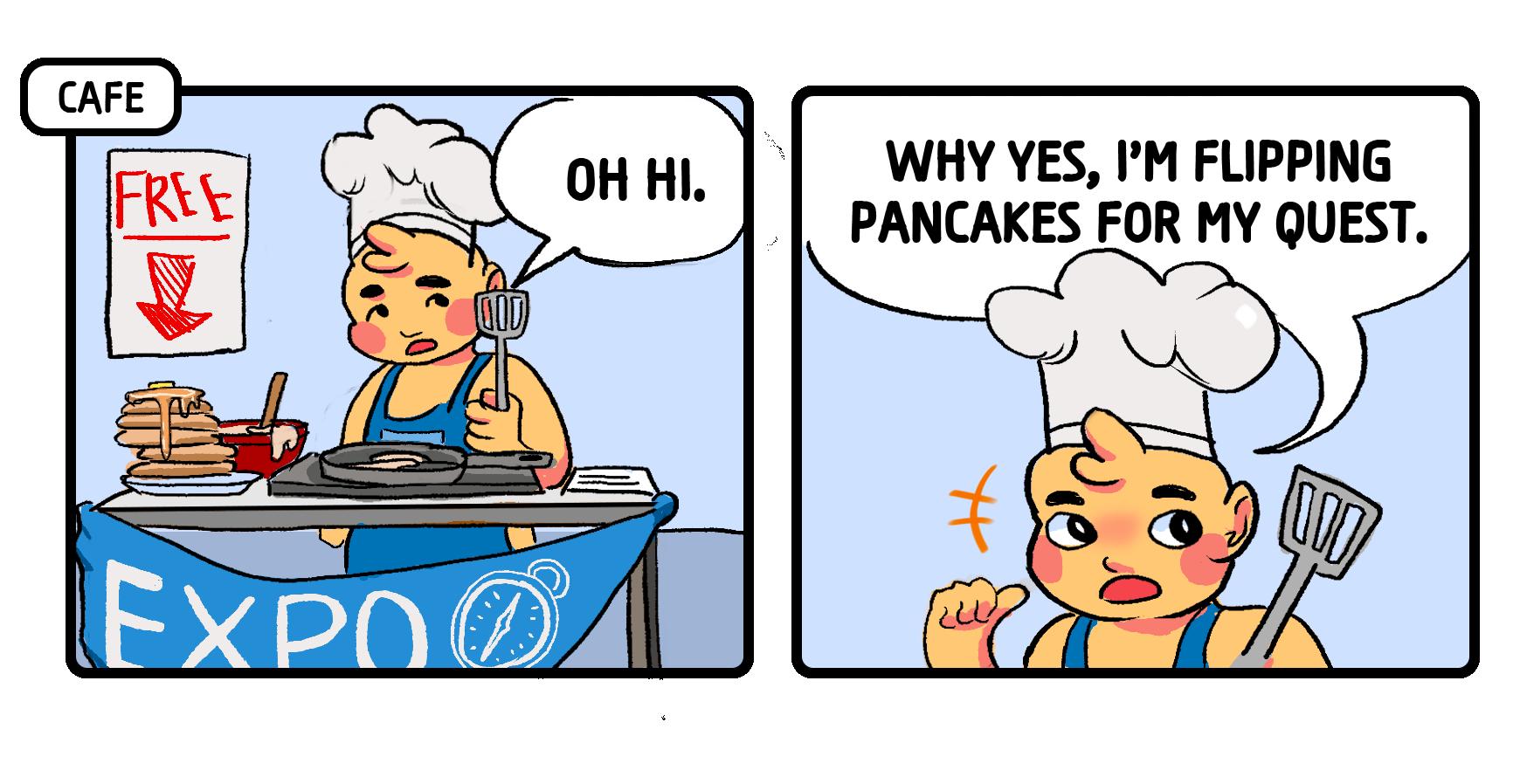
27) Belgrade native 29) Elphaba in Wicked (2024) 34) "Hey Jude" chorus
37) Unsuccessful competitor
38) Stratford's river
39) Party spreads 42) Actor Baldwin
43) Intrinsically 45) Nook and Kindle
47) Glinda in Wicked (2024)
50) Defensive spray
51) Put up with 53) Easy as ___
56) Sugar source 58) Deserve
By Alexis C. Staff Writer
61) Had in mind 63) Obtain, as a suspect, from another
66) Analyze grammatically 67) Show over 68) Annoy
Blue 70) So far 71) CPR pro
Swiss peaks 2) “___ there, done that” 3) Leading 4) Transgender icon Jenner
Honey, casually 6) Wrath

Fill in the 9 by 9 square below with numbers ranging from 1 to 9. Numbers may not repeat within each bolded 3 by 3 square, row, and column.
By Senya S. Staff Writer

A united squad, standout players, and strong teamwork secured a league title and bright future.
By Callum S. Staff Writer
Aunified squad, standout players, and a culture of teamwork led to a league-winning team and a bright future.
This season, the boys soccer team etched their names into the school's history books, winning the Private School Athletic League (PSAL) for the first time in program history with an 8–1–1 division record.
But they didn’t stop there—they also made it to the CCS Division V quarterfinals, where they lost in a close 2-1 game to Silver Creek. It was a season full of firsts, hard work, and heart.
At the center of it all was midfielder Logan X. ’25, who took home the PSAL league MVP award. He wasn’t the only standout, though. Fellow seniors Landon X., Nathan S., Ethan C., and junior Rohan K. earned spots on the PSAL First Team. Up front, sophomore Asher R. led the charge with 12 goals.
This year, though, the difference maker was how the team came together. Players didn’t stick to their standard positions, stepping up wherever they were needed. Landon X. ’25, who usually plays striker, and Rohan, a midfielder, both played center-back to solidify the defense.
“Understanding that our team needed it, we did it for the greater good,” Landon said. “It wasn’t a position we were as good at or wanted to play, but we knew it was necessary.”
These sacrifices ended up paying off, as the team managed to transform what had been an underdeveloped backfield into a solid defensive unit. This move

allowed the team to move younger players forward, which created a more dynamic and balanced attack.
“Having a new mentality and young attacking line allowed the younger players to really shine and show off their skills, which were masked last year,” said Asher.
It wasn’t just about tactics, though, it was also about trust. The willingness to switch positions and take on new challenges speaks volumes about the team's unity.
“There were tighter bonds and a broader sense of camaraderie this year,” said Sam C. ’27. “It allowed for better communication and a better understanding of each other on the field.”
That chemistry showed up in their play, as they racked up 45 goals this season—the most the program has seen since the 2018-2019 season.
Next year will bring some challenges. The team will be losing six seniors, four of whom were crucial parts of the starting lineup, leaving big holes to fill. But the team's foundation is solid. The underclassmen gained valuable starting experience, and the culture of unity and adaptability gives plenty of reasons to be hopeful.
“Next year, we may have a lot of coaching changes and new players coming in,” Landon said. “But I hope we’ll still have the positive team culture we’ve built. As long as that happens, I’m sure there will be a bright future for the team.”

By Senna H. Staff Writer
T
he girls soccer team’s performance at the Central Coast Section (CCS) semifinal marked the end of a successful season both on and off the field.
On the field, they reached a streak of 11 wins in a row, during which they outscored their opponents by an average of 6.6 goals. They ended their season with a 19–3 record, a six-win streak of away games, and first place standing in the Private School Athletic League (PSAL) for the fourth year in a row.
Their last game was a nail-biter against Christopher High School in Gilroy. With a final score of 2–2, after both halves of extra time, the team just barely lost 3–4 in penalty kicks.
“ It was super competitive—we were
down to zero in the first half and then we got back up, which was really exciting. Everyone played super hard, so it was a lot of fun,” said Cassie L. ’28, who scored their first goal after halftime.
Though they had a stellar season, to team members, it wasn’t the goals or wins that mattered—it was the sense of community that they harbored off the field. As a freshman, Zoe K. ’28 highlighted the bond the team had, even across grades.
“[Even though] our age gap is so big, we're still able to make friends in the team and get really close,” Zoe said. “Everybody really cares about each other, not just winning the game.”
But the dynamics of the team extend beyond just being close. Fiona F. ’28



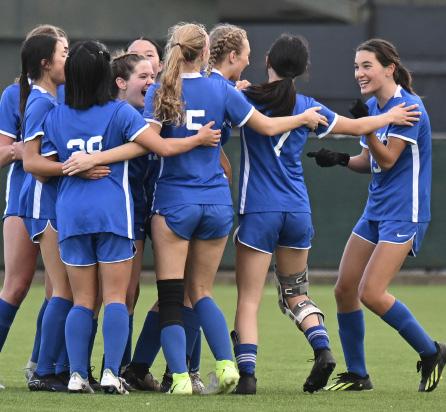
emphasized how the seniors–Lena C., Olivia R., Charlotte R., Luki D., Cameron M., and Devika M.—acted as the glue to the team, bringing the players closer together and inspiring them on and off the field.
“ A lot of [the seniors] kind of act like a mother figure. They're all really supportive,” Fiona said. “All [of] the seniors are my role models, but also my friends.”
It wasn’t only freshmen who

echoed the sentiment of the family-like team. Juliet C. ’26 emphasized both the rapport the team has built and their ability to enjoy themselves while working their
I am most proud of the chemistry that we built as a team, competing at a really high level and making it to the semis while also having fun together,” Juliet said. “It wasn't a toxic environment to be in. It was but we all supported each other.”
By Ellie L. Culture Editor
Matias V. ’26, one of the captains of the Nueva boys volleyball team, has a compliment for every teammate.
The twins, Kai T. ’28 and Zach T. ’28, make the game fun. Beckett B. ’26 always gives him straight feedback. Aryan M. ’25 has a great vertical. Holden K. ’26 brings crazy energy to the court; that extra 10% makes a difference.
“There is an easy chemistry to the team,” Matias said. “And that’s partly because we all have that faith in each other, and have gotten to know each other pretty well.”
It’s a camaraderie that is reflected in the way the team has approached the season so far, which has been marked by a series of nail-splitting games, against opponents in and out of their league. Matias pointed to a particularly exciting five-set match against Crystal Springs Uplands School on March 20. The team lost the first two sets, 23-25 and 24-26, then won the next two sets, 25-16 and 25-20. They narrowly lost the final set, 13-15.
“Throughout the game, I just kept telling the guys to not get bogged down. You made a mistake? Okay, that’s fine, let’s just come back better with more momentum and keep up our morale, which I think did get us into that good zone,” Matias said. “And our bench of players just kept being loud and cheering us on the whole time.”
Beyond the simple cheers from the bench, the team also has their own unique cheer for the game, a long-held team tradition that Ethan E. ’27 described as “essential.”
“Our break from a team huddle is a quick: ‘family on three,’” said Ethan. “And I mean, we are like a family. We support each other, and just want each other to do the
Family on 3! The team huddles up pre game, going over their strategies one last time before their team-favorite family chant. PHOTO BY DIANE
MAZZONI
best we can.”
For Kai T. ’28, it’s the little things like the cheer, as well as pizza dinners and van convos on the way to games, that have made the team environment so welcoming and fun.
“You can tell we all genuinely care and love playing the sport,” Kai said. “[The season] has just been a good time, through and through.”
From team pizza nights to practice, Max E. ’26 has never seen a team dynamic quite like Nueva’s.
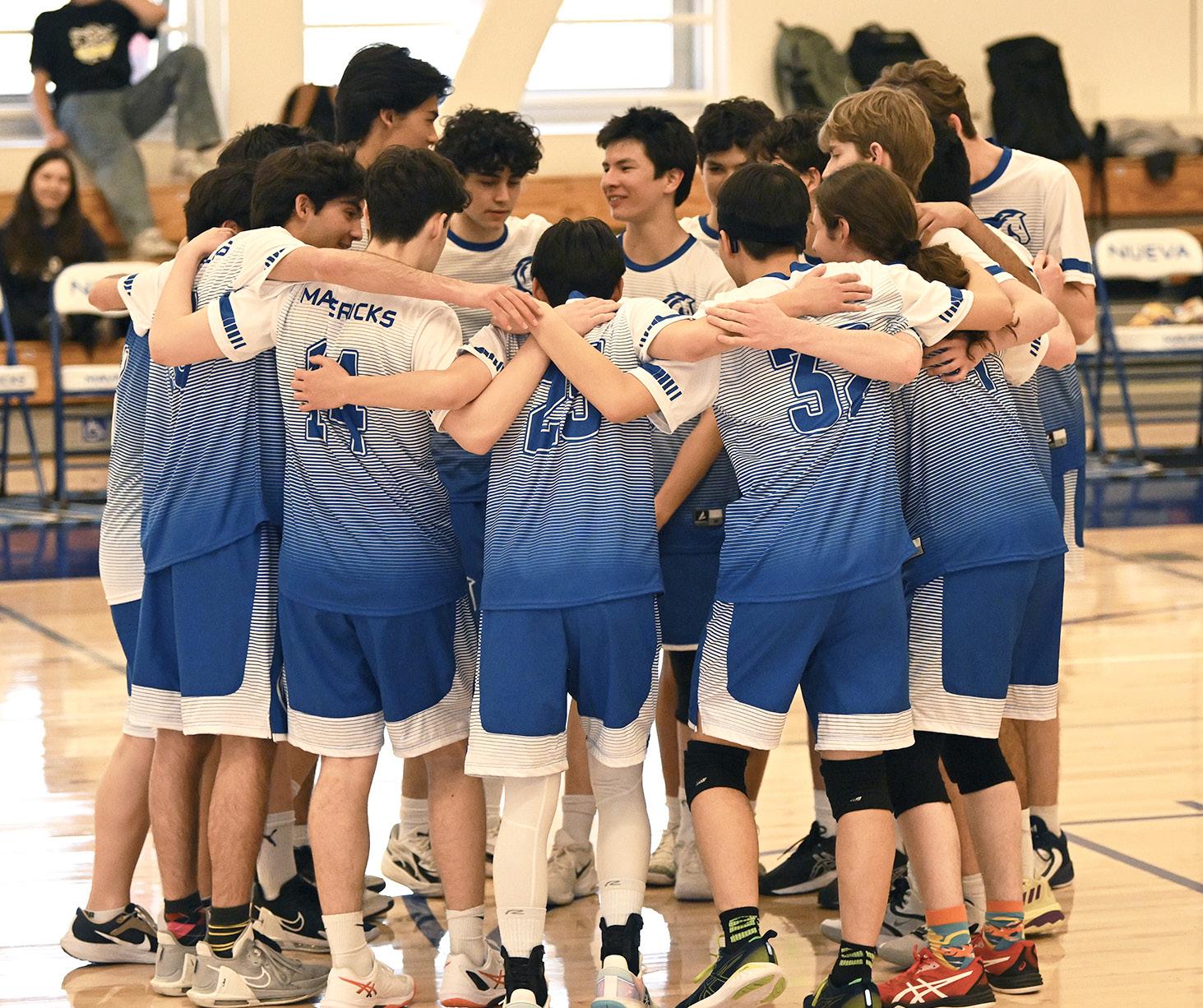
By Emily F. Staff Writer
T
he team starts practice with a quick warmup, footsteps thudding against the floor as they run laps. After, they split into throwers, sprinters, and distance, each with designated coaches and specific workouts.
Jason L. ’28 appreciates the variety of track and field across the many events. “When athletes are running, jumping, or throwing, teammates cheer them on during practices— even though they may be doing a completely different workout,” Jason said. There are many events, ranging from running various distances alone or in relays, shotput, discus, high and long jump, and more.
“Track has been an amazing experience so far! Coming into it for the first time, I was really nervous, but the community that Nueva track has built of both coaches and fellow students was so welcoming,” Langley V. ’28 said.
This year’s track season is off to a strong start. The first meet ended with impressive results, as athletes set multiple personal and school records. The 4x800m relay team surpassed the school’s six-year record with a time of 8:37.48, and Langley broke the record for girls’ shotput with 26 feet 2.25 inches. The second meet was similarly strong, ending with placing in many events and Asher J. ’27 set a new school record in the discus with

76 feet 4 inches. This is only the start.
“I'm looking forward to seeing all of our younger runners grow in their running,” Ryan F. ’26 said.
This excitement is shared by the freshmen.
“Watching teammates grow will be exciting; I've already seen it happen and am looking forward to more impressive PRs from my friends!”
Jason said.
More meets lie on the horizon, keeping the team’s drive to improve high.
“The team's goals are to remain undefeated in the league and then send as many athletes as possible to CCS,” Ryan said.
“Energy is always high, and we’re all dedicated to the team,” Max said. That dedication has been key in keeping the team going this year, having lost several seniors from the team.
“I have trust that the team has adapted, and that we’ll continue to grow,” Max said. “We’ve got new freshmen, new seniors, and everyone keeps getting better.”
Looking ahead, Matias is excited for their next chance to face off against Crystal.
“I know we’ll be even better by then, and it’ll be just some highquality volleyball and points,” Matias said.
He’s also determined to make their senior night game extra special.
“I want to give a proper sendoff to the guys who’ve been on the team since freshman year, and have always tried to get everyone to be energetic and to love the game,” Matias said. “And I also hope we’ll always maintain that spirit.”
varsity tennis team
By Kayla L. Opinion Editor
Playing more tentatively than his usual style, Trevor C. ’28 was not off to the most confident start at his second-ever high school tennis match. He was down 3–4 games against his Pinewood opponent. Then, he won nine games straight, achieved best two out of three sets, and scored Nueva’s first win of the day.
Trevor credited his win to the team’s coach, Gerald Sargeant, for providing constructive advice and encouraging him to play more aggressively. “He said, ‘I don't care if you miss the net. I don't care if you miss long as long as you're just going for it,’” Trevor remembered. “And I thought that was really valuable advice.”
Team members Brooks W. ’26, Niam K. ’26, and Evan W. ’28 also cheered for Trevor on the sidelines. In the past month, the team has played out nine matches—the majority of their season—and has just one remaining. This spring season, the team has enjoyed a newly bolstered coaching staff, an updated training schedule, and several traditions continued from previous seasons.
One of the most impactful developments this season has been the new five-day training schedule and three-person coaching staff. Composed of independent tennis coach Gerald Sargeant, I-Lab Engineer & Design Thinking Teacher Dan Norgan, and newly-hired assistant coach Jay Gubbi, the coaches have ensured that each
player receives individualized feedback during practices and matches, according to team captain Jackson L. ’25. The team previously had two coaches and practiced four days a week.
“Now, we really have the resources to be able to make everyone better at the same time,” Jackson said.
Though the stakes are high, Jackson is focused on himself and guiding the team toward individual achievement. “I really don't mind what the results are for the team because, to a certain extent, you can't really control that. I think the important part is that everyone is trying to be the best tennis player they can be,” Jackson said. “And if we do that, then there's nothing more I can ask.”

One way that Jackson has sought this improvement is by building community and spirit with other team members. At the start of each match, Jackson calls out creative nicknames while announcing players’ position in the lineup. For example, Vian Y. ’26 is “grandmaster Vian” because of his passion for chess, while Evan is “the Hungarian horror.”
The team has also continued their tradition of “Pablo in the Middle.” Jackson says that tradition comes from “Mikey in the Middle,” in which former teammate Michael S. ’24 united the team in a nontraditional huddle before they played. Now, player Pablo Z. ’27 is at the center. “We get in a circle, and we move from side to side. We hype up Pablo, [who is] in the middle,” Trevor said. The team’s traditions will be part of their match against The King’s Academy on April 22, which will finally close out the season for this year.
By Gabriel B. Features Editor
In the absence of a full-time athletic trainer (AT), Director of Athletics Brett McCabe estimated that between 25 and 35 different people have covered the position during the year to date. Based on progress with hiring, the athletics department is unlikely to have a new fulltime trainer before the end of the current school year.
“It hasn’t been ideal, because we’d love to have an athletic trainer who knows our kids inside and out, really gets to know them, and can build that rapport to really help them grow,” McCabe said. “But we’ve done the best with the situation that we’ve been given.”
Keiloni Smith, the former Head Athletic Trainer, resigned last July. At that time, she was on maternity leave taking care of newborn twins and engaged to be married. She had originally planned to return to Nueva, but then her fiancée landed a job in San Diego.
To staff the training room every day, the Athletics Department has contracted ATs from the company Go4Ellis. The system of day-by-day fill-ins served Mavericks athletics for the fall and winter seasons and now continues into the spring.
“The most important piece is that we’ve had somebody here physically every day to assist our student-athletes who needed it, whether it be ice or just some sort of treatment or evaluation,” McCabe said. “Or, when we’re hosting events, but we’re even off campus, we make sure we have athletic trainers at those sites too.
They’ve been able to cover and do a great job, because in the immediate [timeframe] they’ve been able to handle those situations.”
Despite athletic admin’s best efforts, student-athletes have still experienced challenges with the AT arrangements.
Mia B. ’27, a setter for varsity girls volleyball and sprinter for the track team, has met with four or five different ATs this year. She has repeated a description of her injury to each trainer, but received mixed messages back.
“During volleyball games there would always be one, which was nice, but definitely the inconsistency of treatment was a problem because they all have different ways of handling the same issue,” she said.
Moreover, the contracted ATs have not always arrived by the time practices start.
“There were a few days this semester where there were no athletic trainers when I needed one,” Mia said.
Julia R. ’26, a three-sport athlete in cross country, basketball, and track, has tried to meet with the same trainer as much as possible.
“I just don’t like seeing somebody who I don’t know at all,” she said.
For a lingering overuse injury one trainer has helped her with, Randolph hesitates to check in with another AT who would be new to the situation.
Having a full-time AT should naturally resolve athletes’ current problems with unfamiliarity, mixed advice, and unavailability.
The Athletics Department posted
By Natalia R. Staff Writer
G
olf has one of the smaller teams at Nueva, with only six players on the course at a time. Despite its size, the team is playing at some of their best levels yet. Due to the small roster, every player’s scoring average holds significant weight.
This season, the team is aiming for their best.
“Our team is doing better this year, so I think this is going to be our strongest season so far,” said Cami Y. ’25.
Cami, along with James L. ’25, have been co-captains of the team for three years—boosting team morale and encouraging camaraderie both on and off the course with team dinners.
When the team travels to practices and games, they all fit in one van—getting even closer in the process.
With the way golf matches are played, where different players pair up for each tournament, building strong relationships has come naturally.
“We get to know each other that way as well,” Yen said.
Golf pairings are determined by two factors: personal choice and a player’s seed. A player’s seed is their ranking in a tournament. Although golf is largely an individual sport, with each player’s scores added up at the end of the match, the team encourages each other collectively.
The newest member of the team, Bence O. ’28, is the only freshman. Still, his high seed has allowed him to compete alongside teammates across grades.
“It’s great being mentored by people that have more experience playing high school golf,” Bence said. “I’m learning a lot, and it’s nice to have their support.”
So far, the team has played eight tournaments, starting the season 4-0 and now standing at 6-2. These games have taken place on courses at Stanford, Boulder Ridge, the Moffett Field, and Baylands GL.
Out of the seven teams that play in the WBAL league, Nueva currently sits in second place, with Crystal in first and Menlo in third.

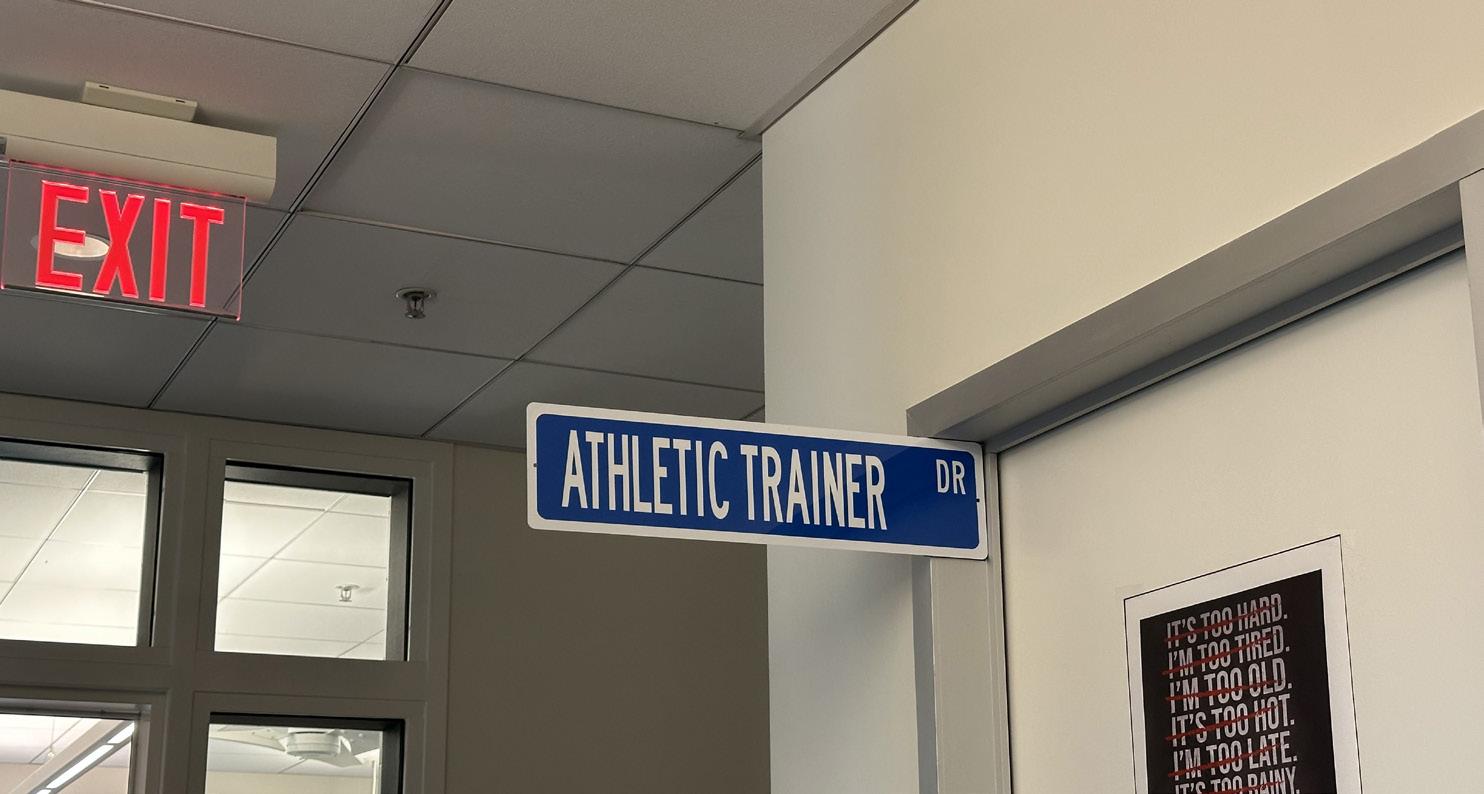
the AT position opening after Smith announced her departure, but since it was late summer, most ATs had already signed on for the coming school year. Barely any applications came through, and McCabe was wary that any candidate who did apply had likely been rejected or unwilling to commit elsewhere.
McCabe and Assistant Director of Athletics Robert Lopez reached final interviews and campus visits with a few candidates, but ultimately decided they were not the best fit.
“We weren’t going to just settle,” McCabe said. “We want to make sure we get the right person, because our athletic department is not that big as it is.”
In standard practice, athletics trainers are responsible for addressing student-athletes’ injury and other sports wellness needs, providing access to treatment and guidance. For McCabe and Lopez, the best “fit” for the position would be someone prepared to take a fairly active role in the administration side
as well, on top of athletic trainer duties.
In the meantime, the athletics department team members have had to pick up additional tasks.
“It’s been a collective team effort from not only the athletic admin team, but also some of our contracted ATs that we’ve seen a little bit more regularly,” McCabe said.
In lieu of a full time AT, Head Strength and Conditioning Coach Nick Hryekewicz has processed the clearance paperwork that allows athletes to practice and compete. “Athletic Assistant” is now in his official job title. One part-time AT lent a hand by putting a supply order together and redesigned the athletic training room.
Fortunately, the number of applications recently rose significantly, and some candidates will come in for final interviews soon. According to McCabe, realistically, they are applying to start full-time next year, possibly over the summer.
By Alexis C. Web Editor
On March 19, the varsity swim team competed in their first meet of the season at the Harker School. Six students debuted on the Nueva team, 40 races were swam, and 15 personal records were broken.
In the 200-meter medley relay, three sophomores swam their anchor legs. Both Amalia C. ’27 and Hannah F. ’27 set new personal bests in the 50-meter freestyle, while Timothy C. ’27 anchored in freestyle for his debut on the team.
Junior Remi H.C. dropped 3 seconds off of his previous best time in the 100-meter butterfly, winning the event and qualifying for the CCS championships.
The 100-meter breaststroke closed up the meet, with three freshmen Elin R., Maya M., and Ryan Y. all debuting in the event.
Meera N. ’27, who beat her time in the 50-meter backstroke from last year’s WBAL championship, feels the team’s excitement for the upcoming season. “We have a lot of personal records, and I think there’s a good chance a lot of the people in the team will make it to WBAL finals,” Meera said. “There’s a lot of excitement and possibility.”
With potential brewing in the air, the team is hopeful for the season to come.
